
Mayflower400 partner destinations:

The Mayflower Story
- Stories of the Mayflower
The Mayflower set sail on 16th September 1620 from Plymouth, UK, to voyage to America. But its history and story start long before that.
Its passengers were in search of a new life – some seeking religious freedom, others a fresh start in a different land. They would go on to be known as the Pilgrims and influence the future of the United States of America in ways they could never have imagined.
This story isn't just about the Mayflower's passengers though. It's about the people who already lived in America and the enormous effect the arrival of these colonists would have on Native Americans and the land they had called home for centuries.
More than 30 million people can trace their ancestry to the 102 passengers and approximately 30 crew aboard the Mayflower when it landed in Plymouth Bay, Massachusetts, in the harsh winter of 1620.
On board were men, women and children from different walks of life across England and the city of Leiden in Holland.

A significant number were known as Separatists, a group of people who mostly wanted to live a life free from the current Church of England.
Others were on the ship for a multitude of reasons – some anticipated the chance to build a better future for their families and the opportunity of new land, while for others the offer of freedom and adventure was too good to turn down.
Then there were the crew themselves, plus the servants and unaccompanied children sent by their families to be looked after by the adults.
The passengers are often grouped into ‘Saints’ or ‘Strangers’ by historians, alluding to their motivations for the journey. But it’s likely that many ‘Saints’ were skilled tradesmen and many ‘Strangers’ had their own religious reasons for leaving 17 th century England.
The origins of these passengers can be traced across England and in the Netherlands – as illustrated by the interactive map below.
Importantly, the Pilgrims were not the first to land in America, nor did they discover it. There were already established colonies at the time, not least Jamestown – founded in 1607.
But the Mayflower story is renowned for its themes of freedom and humanity – including the relationships first formed between the Native American Wampanoag tribe and the colonists and the first Thanksgiving.
We begin much earlier than 1620, in the villages, towns and cities of England.
The King of England
The decision by Henry VIII to break away from the Roman Catholic Church – principally so he could divorce his first wife, Catherine of Aragon, had far-reaching ramifications.
He created his own church, with its own rules determined by him - called the Church of England. In doing this, Henry was expelled by the Pope and the reformation of the English churches had started.
Many believed that Henry’s new church was still too similar to the Pope’s and wanted even more changes. Some wanted to separate it from other churches by purifying it of all Catholic practices. They became known as the Puritans.
However, others believed that you could not change the church and that the only way to form a new group was to break away entirely. They became known as the Separatists.
The Church dictated all aspects of life – from what you ate to what you wore. To dispute that rule was a dangerous path ending in prosecution. This was especially foreboding for Separatists.
The Separatist leaders
The leading religious Separatists who voyaged to America in 1620 mostly originated from an area where modern-day Nottinghamshire, Yorkshire and Lincolnshire meet.
Regarded as dangerous renegades who rejected fundamental principles of the State and the established Church of England, they worshipped in secret to avoid arrest and persecution.
Among them was William Brewster, who was brought up in the village of Scrooby in north Nottinghamshire.
Inspired by the radical words of Richard Clifton, the rector of nearby All Saints' Church in Babworth , Brewster is believed to have founded a Separatist Church in his family home - the manor house at Scrooby.
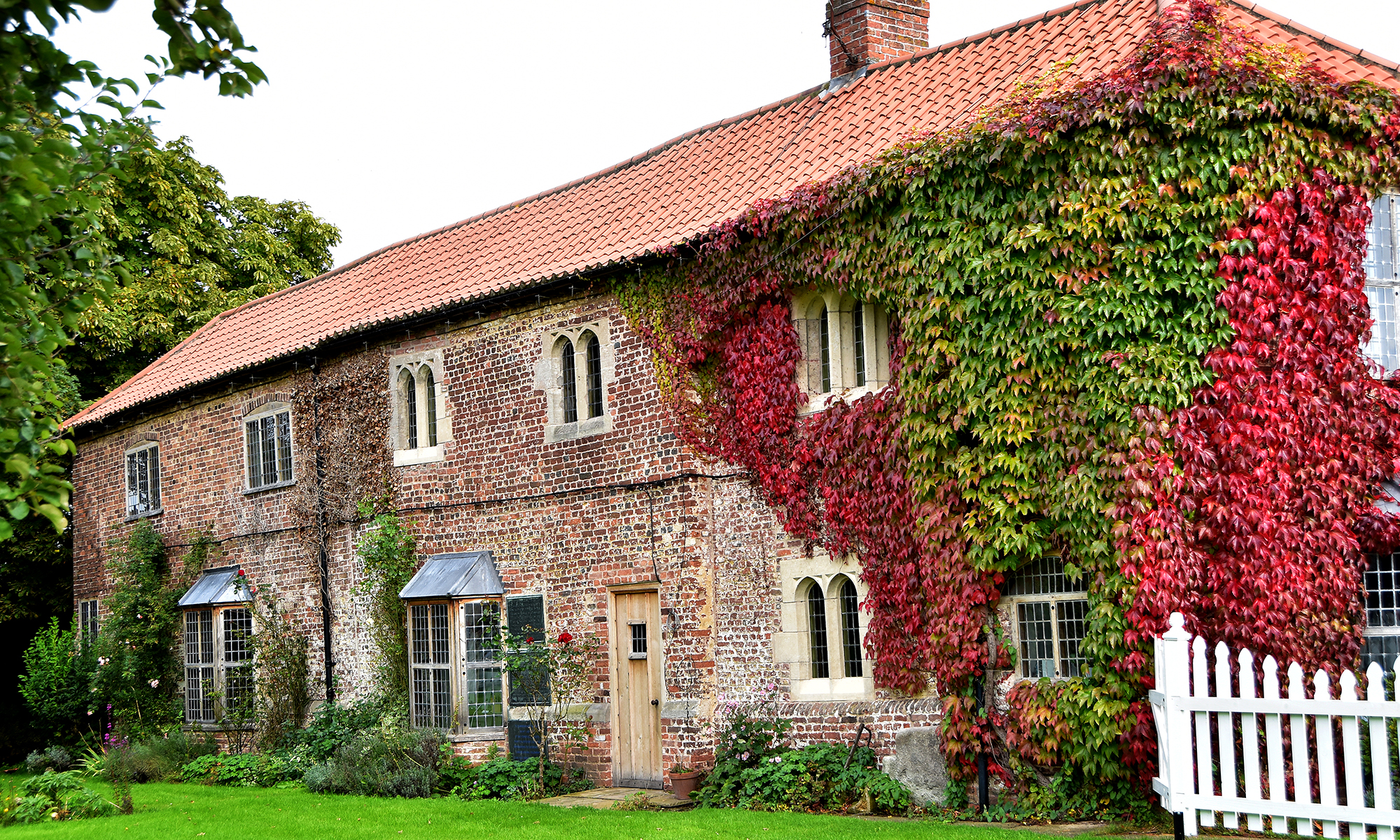
Scrooby Manor House
He was fined for non-attendance at St Wilfrid’s Church in Scrooby but was respected as an elder and spiritual guide and played a significant role in the congregation’s later journeys.
Brewster strongly influenced William Bradford from Austerfield, a nearby South Yorkshire village. When the Separatists landed in America, Bradford went on to become a Governor of the Plymouth Colony, serving for more than 30 years.
William Bradford’s journal, Of Plimoth Plantation, records much of what happened to the group, including how they had become so persecuted that they could no longer live peacefully.
Bradford was baptised St Helena's church where the original font can be seen today. Heavily influenced by leading Pilgrim William Brewster, he was a sickly young orphan when they first met, but grew into a passionate religious radical.
A similar group had long been growing in the nearby town of Gainsborough in Lincolnshire, drawing members from surrounding villages. They would also worship clandestinely under the guidance of John Smyth at the Gainsborough Old Hall.
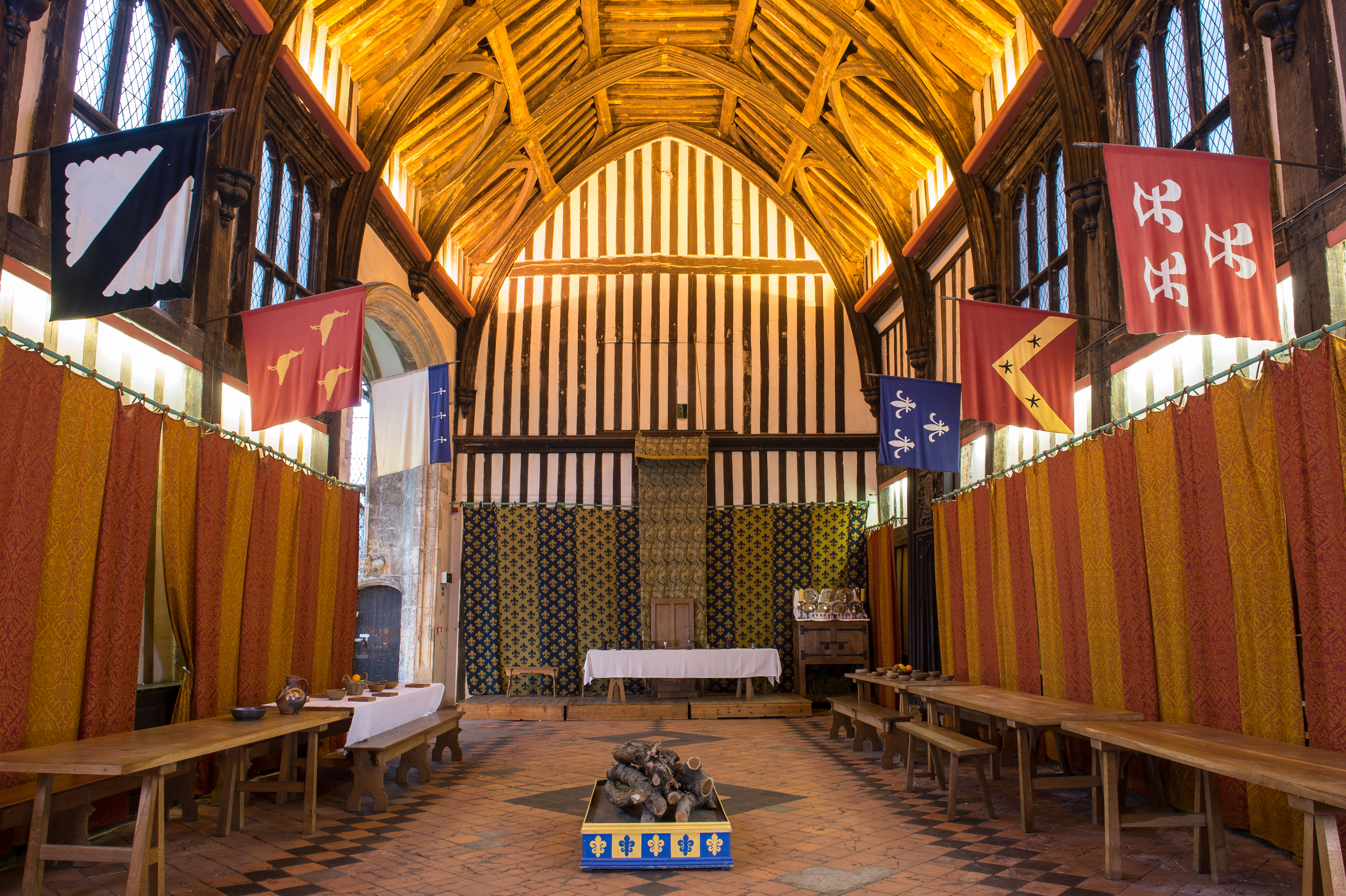
Inside Gainsborough Old Hall
Escaping to Holland
As the authorities intensified their crackdown on the Separatists, the two groups decided to flee England for Holland – seen as a liberal nation where they could live peacefully.
One night in the autumn of 1607, they secretly met a boat on the edge of ‘The Wash’ at Scotia Creek, near Boston in Lincolnshire – some having walked 60 miles.
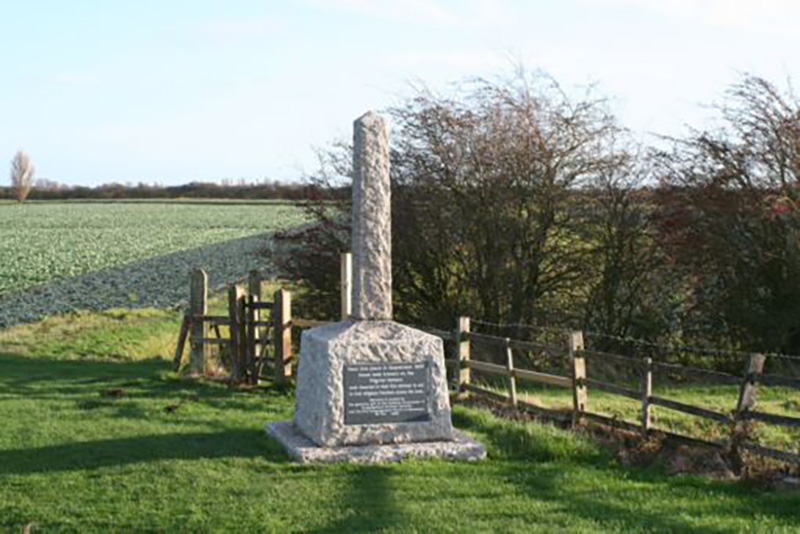
The monument at Scotia Creek that marks where the Pilgrims tried to make their escape
But the captain of a ship betrayed them and the local militia seized the group and took their money, books and personal possessions. Stripped of their belongings and hope, the group were brought by boat back to Boston and held and tried at the Guildhall, home to the local law court and cells.
They were eventually freed and made a second, successful attempt at fleeing to Holland – this time from the coastal town of Immingham in Lincolnshire.
A new life in Leiden
They settled in the city of Leiden via Amsterdam. Leiden was a city of free-thinkers, relative religious tolerance, and a long tradition of offering shelter to the dispossessed.
They built a life in Leiden, living and working here for 12 years. They built land near the spectacular Pieterskerk church and built houses in what is today known as the Engelse poort (English Alley).
Many worked in the textile industry and similar trades – but it was hard work and a challenging life. William Brewster operated a printing press in what is today known as ‘William Brewster Alley’. Here he produced dissident pamphlets that were smuggled into England for distribution.
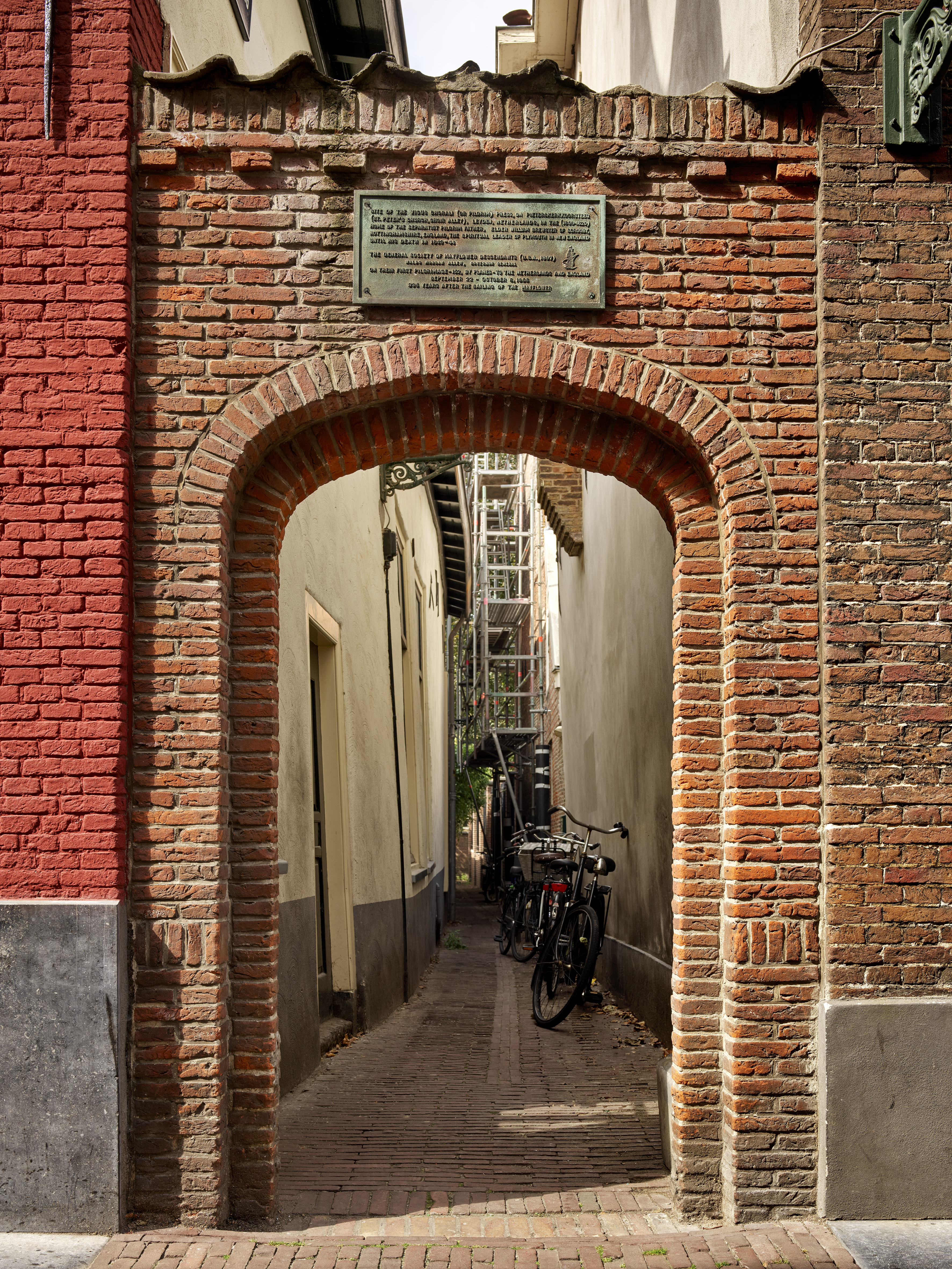
William Brewster Alley
Eventually the time in a foreign land took its toll and the group started to plan a journey to a new land to start again.
It’s thought there were several reasons for this – not least that the fear their children were effectively growing up as Dutch children.
They wanted to find a place completely free of limitations where they could build a better economic future. They had been living in small houses with big families – and were becoming poor.
The looming threat of war with Spain also cast a cloud over their future.
From 1617 they planned to leave and eventually settled on Virginia in America.
More than half of the group stayed though and fully integrated into Dutch life. Among them was John Robinson, known as the ‘pastor to the Pilgrims’.
Leiden had a profound influence on the lives of the Pilgrims - even after their departure. The concept of civil marriage was one innovation they took with them.
Planning the voyage to America
Virginia in America was an attractive destination because several colonies had already settled there. However, they also felt that they should not settle too near and end up with a similar environment to which they originally fled.
The Separatists worked with their counterparts in England to fund and organise the journey – which had to make commercial sense.
They negotiated with merchants in London and convinced them that funding their journey would see a return on investment thanks to the goods they would be able to send back to England. They also needed permission to land in Virginia and establish a colony.
A ship called the Speedwell would carry the Leiden group to America while another ship called the Mayflower was hired to take passengers who weren’t necessarily travelling for religious reasons.
The Mayflower would sail from the port of Rotherhithe in London, carrying many there for work in the new land, who simply wanted to build a new life, crew and servants. Rotherhithe was home to many of the crew including the Mayflower's Captain Christopher Jones .
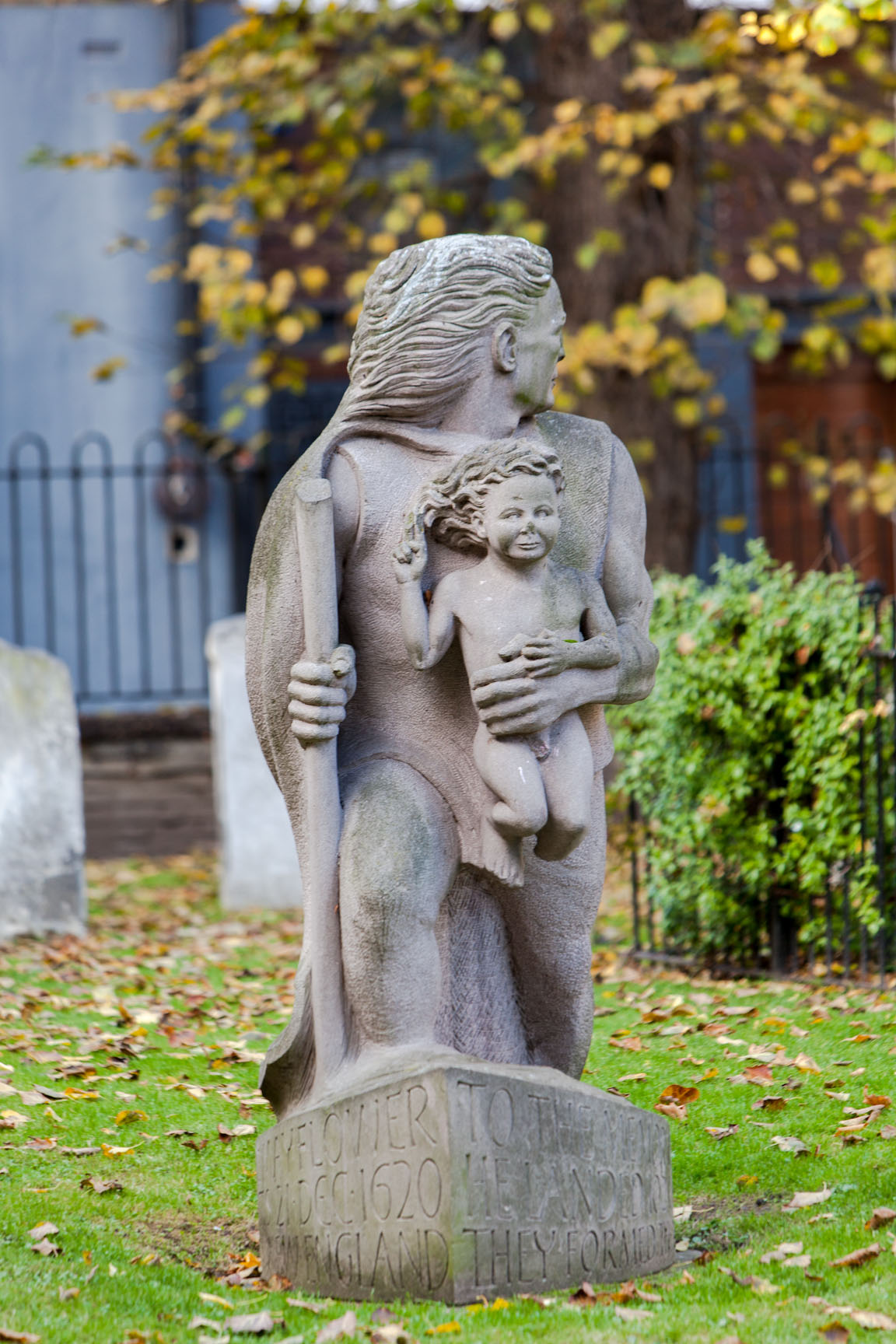
A statue of Christopher Jones found in St Mary's Church in Rotherhithe
Leaving England
The Speedwell set sail from Holland on 22 nd July 1620, after a moving ceremony by the water’s edge.
The plan was to meet the Mayflower in Southampton before heading off together across the Atlantic.
Southampton was a thriving seaport offering all the commercial facilities to provision and equip for the long sea voyage. Many of the buildings and streets familiar to the passengers then still exist.
When the two ships met in the port there were concerns about the Speedwell though, which needed repairs after developing a leak. But on 15th August 1620 the two ships weighed anchor and set sail from Southampton.
The two ships didn’t get very far when the Speedwell began to take on water again. It may have been because she carried too much sail, straining her timbers, or the direct result of sabotage by a reluctant crew.
They changed course for Dartmouth , a port on the south coast of Devon. It took about a week for the port’s skilled craftsmen to make good the damage.
Unfortunately, the second attempt did not go as hoped either. The Mayflower and the Speedwell were 300 miles clear of Land’s End when the smaller ship yet again began leaking badly and could not risk continuing. The two boats turned about for Plymouth .
One last stop
By this time, the cramped, damp and miserable passengers had already spent up to six weeks at sea. With a fair wind and good fortune, they would have hoped to be nearing America by then.
The Speedwell was finally declared unfit for the journey. Some of the Pilgrims dropped out. The remainder crowded onto the Mayflower, which required re-provisioning, despite funds running low.
They left Plymouth on 16 th September 1620, with up to 30 crew and 102 passengers on board. Just under half of them were Separatists, or Saints. They used the name Saints as a way to indicate that they were part of a particular group with a certain set of beliefs.
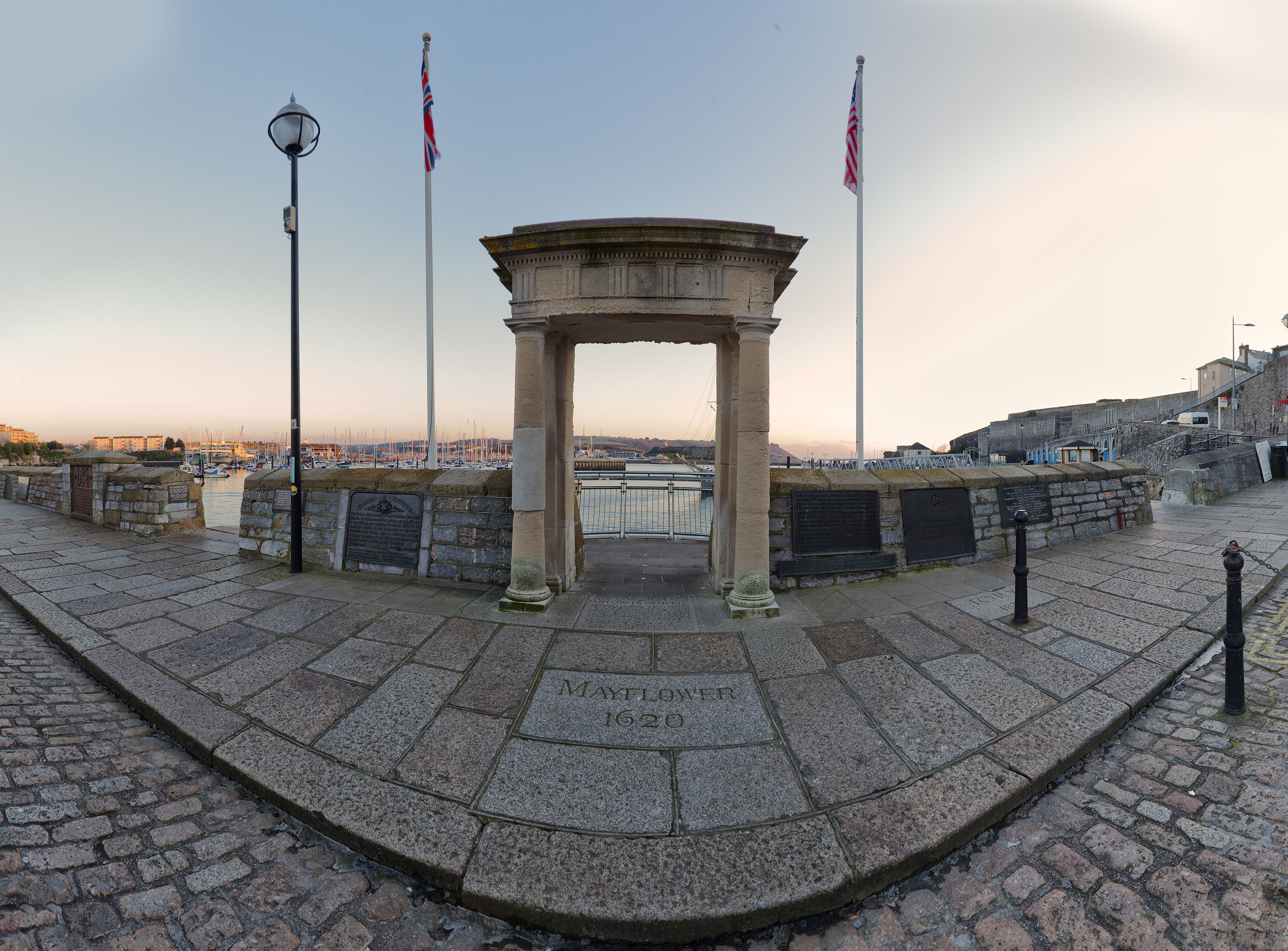
The Mayflower Steps in Plymouth, built as a memorial to the historic voyage
The rest were known as Strangers, as this is how the Saints viewed all others outside of their group. Many were skilled tradespeople sent by the investors to help build the new colony. Though plenty of the passengers could have probably been defined on either side of this divide.
The passengers
The following passengers were on board the Mayflower:
- Isaac and Mary (Norris) Allerton, and children Bartholomew, Remember, and Mary
- John Allerton
- John and Eleanor Billington, and sons John and Francis.
- William and Dorothy (May) Bradford
- William and Mary Brewster, and children Love and Wrestling
- Richard Britteridge
- Peter Browne
- William Butten
- Robert Carter
- John and Katherine (White) Carver
- James and Mrs. Chilton, and daughter Mary
- Richard Clarke
- Francis Cooke and son John
- Humility Cooper
- John Crackstone and son John
- Edward Doty
- Francis and Sarah Eaton, and son Samuel
- Thomas English
- Moses Fletcher
- Edward and Mrs. Fuller, and son Samuel
- Samuel Fuller
- Richard Gardiner
- John Goodman
- William Holbeck
- Stephen and Elizabeth (Fisher) Hopkins and children Constance, Giles and Damaris; son Oceanus was born during the voyage.
- John Howland
- John Langmore
- William Latham
- Edward Leister
- Edmund Margesson
- Christopher and Mary (Prower) Martin
- Desire Minter
- Ellen, Jasper, Richard, and Mary More
- William and Alice Mullins and children Priscilla and Joseph
- Degory Priest
- Solomon Prower
- John and Alice Rigsdale
- Thomas Rogers and son Joseph
- Henry Samson
- George Soule
- Myles and Rose Standish
- Elias Story
- Edward Thompson
- Edward and Agnes (Cooper) Tilley
- John and Joan (Hurst) Tilley and daughter Elizabeth
- Thomas and Mrs. Tinker, and a son
- William Trevore
- John Turner, and two sons
- Richard Warren
- William and Susanna (Jackson) White, and son Resolved(son Peregrine was born shipboard in Provincetown Harbor after arrival).
- Roger Wilder
- Thomas Williams
- Edward and Elizabeth (Barker) Winslow
- Gilbert Winslow
- Dorothy (John Carver's maidservant)
Source: New England Historic Genealogical Society
Sailing the Atlantic
The Mayflower took 66 days to cross the Atlantic – a horrible crossing afflicted by winter storms and long bouts of seasickness – so bad that most could barely stand up during the voyage.
By October, they began encountering a number of Atlantic storms that made the voyage treacherous. It was so bad that the sails often could not be used, instead they simply drifted.
One Stranger was swept overboard and one woman, Elizabeth Hopkins, gave birth to a baby boy, aptly named Oceanus.
The Pilgrims intended to land in Northern Virginia and the Hudson River (today New York) was their intended destination. They had received good reports on this region while in the Netherlands. The Mayflower was almost right on target, missing the Hudson River by just a few degrees.
As they approached land, the crew spotted Cape Cod just as the sun rose on November 9, 1620.
The Pilgrims decided to head south, to the mouth of the Hudson River in New York, where they intended to make their plantation.
But the rough seas nearly shipwrecked the Mayflower and instead they decided to stay and explore Cape Cod rather than risk another journey south. They anchored in what is now Provincetown Harbor. Shortly after, Susannah White gave birth to a son aboard the Mayflower, the first English child born in the colony. He was named Peregrine, derived from the Latin for ‘pilgrim’.
The Mayflower Compact
The colonists knew they had no right to settle in this land they had unintentionally arrived upon and decided to draw up a document that gave them some attempt at legal standing.
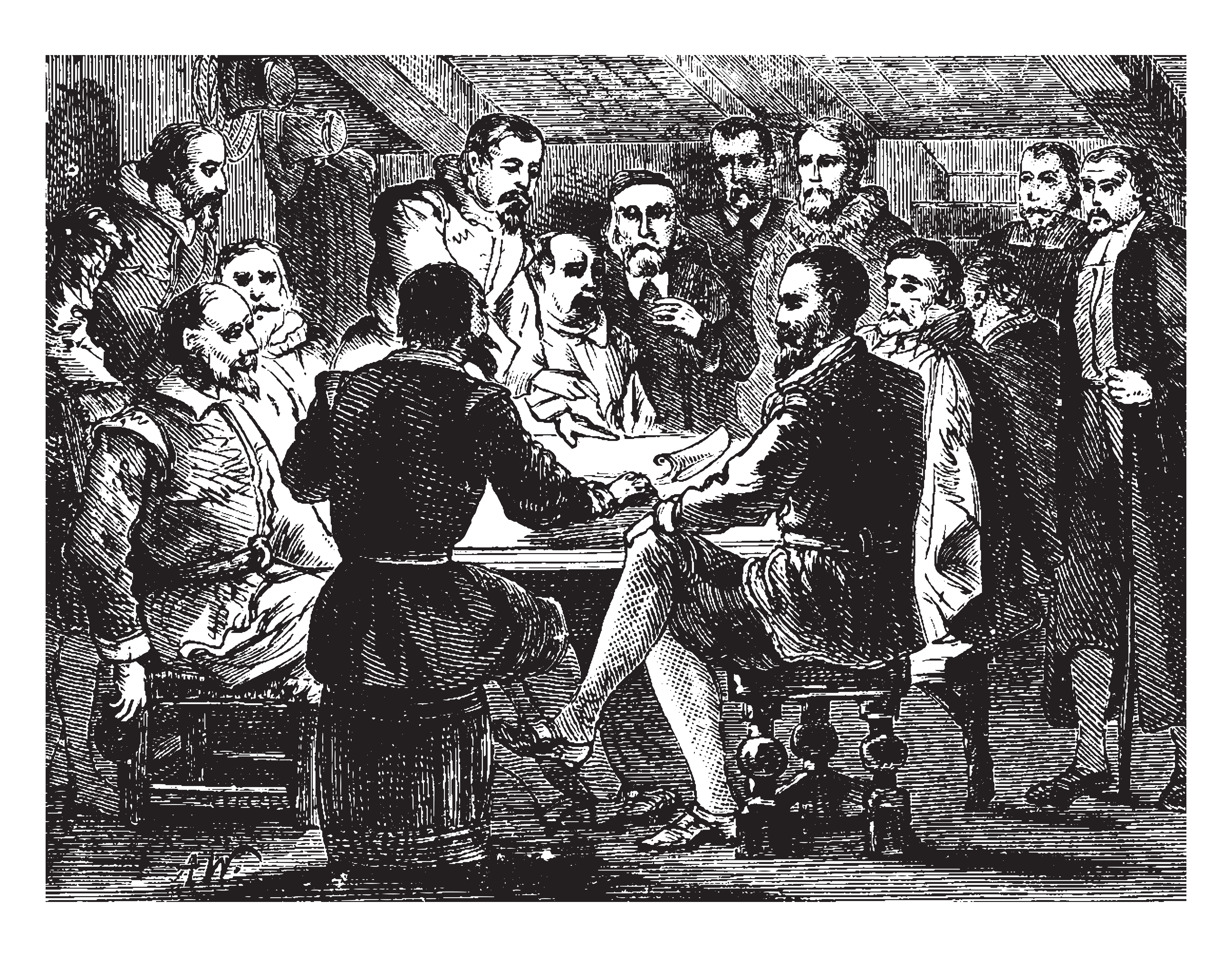
An illustration of the signing of the Mayflower Compact
So upon arrival the settlers drew up the Mayflower Compact. Signed by 41 men on board, the compact was an agreement to cooperate for the general good of the colony. They would deal with issues by voting, establish constitutional law and rule by the majority.
The document read:
In the name of God, Amen. We, whose names are underwritten, the loyal subjects of our dread Sovereigne Lord, King James, by the grace of God, of Great Britaine, France and Ireland king, defender of the faith, etc. having undertaken, for the glory of God, and advancement of the Christian faith, and honour of our king and country, a voyage to plant the first colony in the Northerne parts of Virginia, doe by these presents solemnly and mutually in the presence of God and one of another, covenant and combine ourselves together into a civill body politick, for our better ordering and preservation, and furtherance of the ends aforesaid; and by virtue hereof to enacte, constitute, and frame such just and equall laws, ordinances, acts, constitutions and offices, from time to time, as shall be thought most meete and convenient for the generall good of the Colonie unto which we promise all due submission and obedience. In witness whereof we have hereunder subscribed our names at Cape-Codd the 11. of November, in the year of the raigne of our sovereigne lord, King James, of England, France and Ireland, the eighteenth, and of Scotland the fiftie-fourth. Anno Dom. 1620.
Watching from the west
The Pilgrims would spend the next month and a half exploring Cape Cod, while most stayed on board the ship, trying to decide where they would build their plantation.
They searched much of the coastline in this region including the area now known as Plymouth.
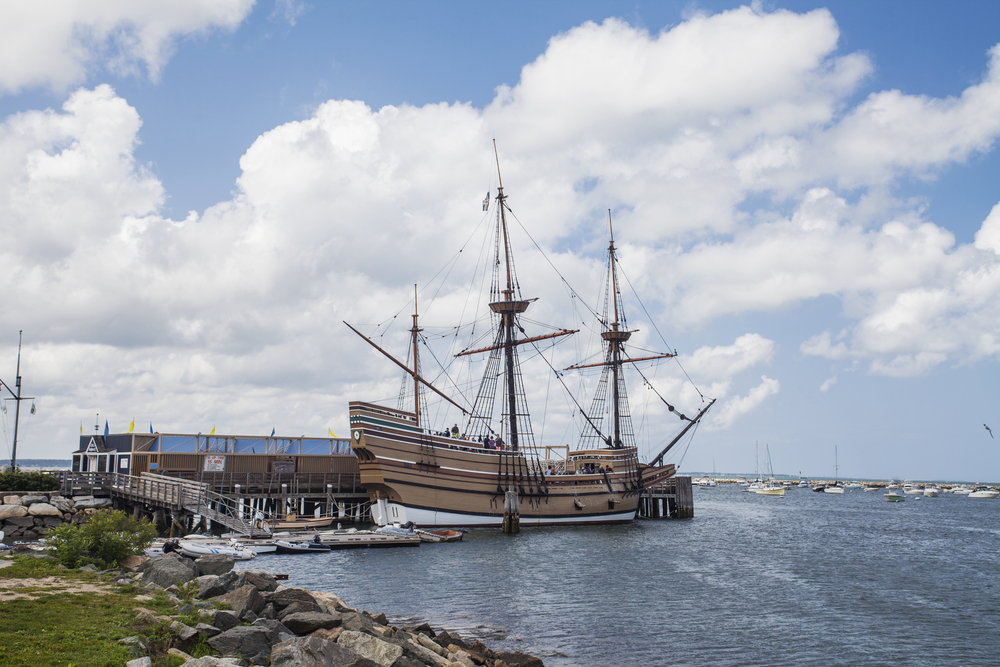
The replica Mayflower in Plymouth, Massachusetts today
Watching on were a small group of Native Americans, people for whom this area was already home. The new arrivals tried to follow them but got lost and stuck among some dense thickets. They decided to change course and came across cleared land where corn had been grown and abandoned houses.
They found buried corn, which they took back to the ship, intending to plant it and grow more corn, eventually returning what they had taken. They also found graves.
This village they had stumbled upon was once called Patuxet but had since been deserted following the outbreak of disease.
This was a legacy of what the Native American people had already experienced from European colonists in the 17 th century.
The native inhabitants of the region around Plymouth Colony were the various groups of the Wampanoag people and other tribes, who had lived there for some 10,000 years before the Europeans arrived.
The Great Dying
When the Separatists were living in Leiden in 1616, in the same year a map was published detailing explorations of the Cape Cod area to the Bay of Fundy.
But these names were meaningless to the people who lived in this region, which is thought to have been known as Dawnland.
And to them 1616 was memorable for very different reasons – the outbreak of European diseases that would devastate their communities.
Ships from England had been fishing and trading in North America waters since the beginning of the 16 th century. They would also bring Native Americans back to Europe – some as slaves – often to callously exhibit.
Some were taught English so they could become interpreters in future. In 1614, six years before the Pilgrims arrived, 27 natives were seized by a man called Thomas Hunt.
The majority came from Patuxet, the very abandoned village the Pilgrims would later find, and what is now modern-day Plymouth, Massachusetts.
One of these was named Tisquantum (also known as Squanto). Hunt tried to sell the natives as slaves in Spain but somehow Tisquantum made his way to England, where he learned some English and was used as an interpreter in future trips to America.
Eventually he found his way back to Patuxet, where tragically he found his family and village had been wiped out by disease brought by European settlers and explorers.
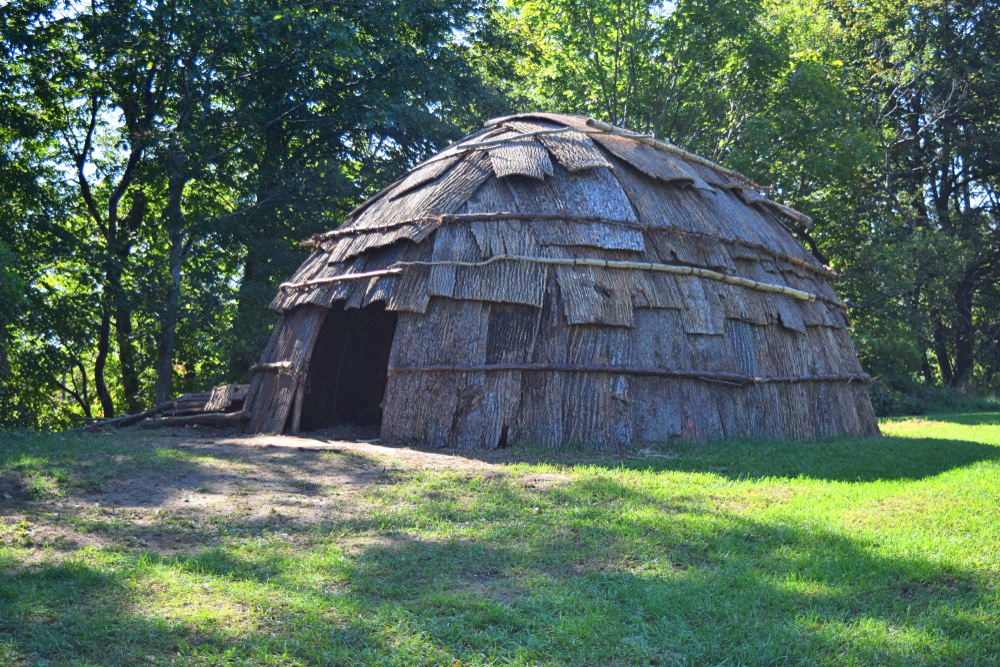
A Wampanoag hut
Between 1616 and 1619 a mysterious disease that would become known as the ‘Great Dying’ ravaged this region, before the Mayflower laid anchor in Cape Cod.
In the winter of 1616-17 an expedition dispatched by Sir Ferdinando Gorges found a region devastated by war and disease, the remaining people so "sore afflicted with the plague, for that the country was in a manner left void of inhabitants."
Two years later another Englishman found “ancient plantations” now completely empty with few inhabitants – and those that had survived were suffering.
So before the Mayflower arrived, this region had greatly suffered from the effects of colonisation.
The first harsh winter
Before settling on what is now Plymouth, the Pilgrims explored other areas of the coast, including an area inhabited by the Nauset people. They saw some figures on the shore who fled when they approached. They explored and found more graves, which they decided not to dig.
They remained ashore overnight and the following morning, they were attacked with arrows. The colonists shot back with guns but could not find them. That would be the last contact until the spring.
On December 25, 1620, the Saints and the Strangers departed the bleak shores of Provincetown and arrived, finally, in what is now Plymouth Bay, Massachusetts, on 26 th December 1620.
They decided this place, once home to the people of Patuxet, would be where they settled and began construction of their first buildings.
But the first winter was cold and many of the passengers stayed on board the Mayflower. The ship became home to the sick and dying, with many succumbing to a mixture of contagious diseases.
Building the colony
The settlement’s first fort and watchtower was built on what is now known as Burial Hill (the area contains the graves of Bradford and other original settlers).
The first common house nearly completed in January, built for general use. Each single man was ordered to join himself to one of the 19 families in order to eliminate the need to build any more houses than absolutely necessary.
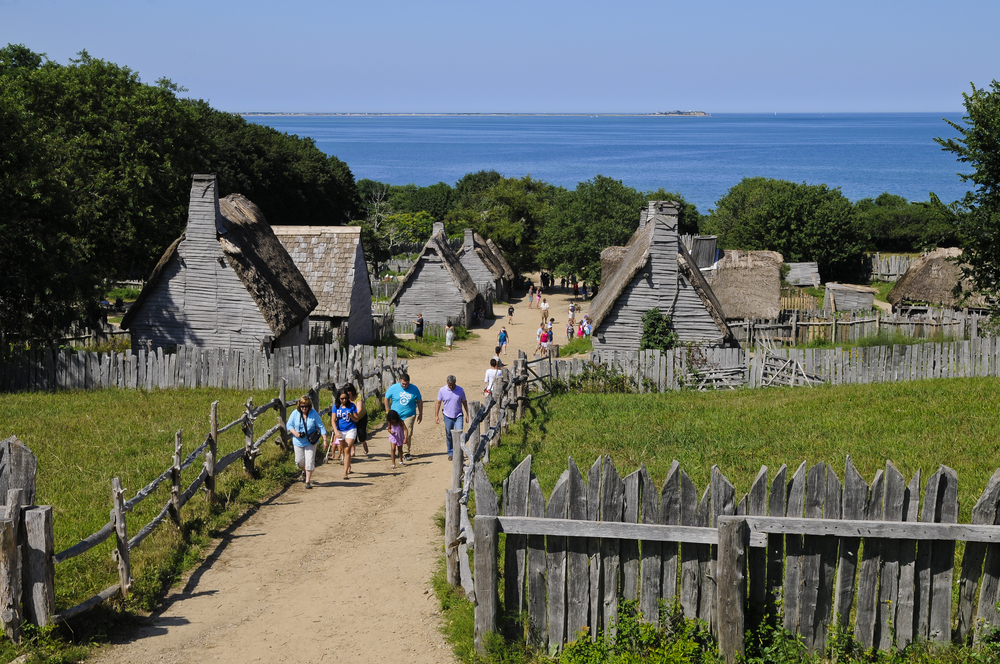
The Plimoth Plantation recreation of the village
Each extended family was assigned a plot and they each built their own home and the settlement was mostly built by February.
The first house was built as a hospital. Thirty-one of the company were dead by the end of February, with deaths still rising. Coles Hill became the first cemetery, on a prominence above the beach
Only 47 colonists had survived and at its worst just six or seven were able to feed and care for the rest. In this time, half the Mayflower crew also died.
When his crew began to recover from disease, the Mayflower’s captain Christopher Jones sailed the ship back to England, taking half the time that it did on its outward journey.
The Wampanoag and the Pilgrims
The Pilgrims were settling on land home to the Wampanoag – one of many tribes in the wider region. The Wampanoag had lived here for 10,000 years before they arrived.
Each tribe in New England had their own territory in which to fish, harvest and hunt. The boundaries for hunting were very strict as some areas had large populations.
The Wampanoag people knew how to work with the land and moved between sites to get the best of their harvest. They spent the summer near the shore and the winter in land, amongst the woods.
The Wampanoag worked together - a number of groups united together. A head Sachem managed a Sachem from each of the groups. Within this organisation, family and group links were the most important, connecting them to each other and their territory.
In the years before the Mayflower landed, The Wampanoag had been attacked by neighbouring tribes, losing land along the coast. Then came the Great Dying and the losses were so devastating that the Wampanoag had to reorganise its structure and Sachems had to join together and build new unions.
A historic peace
During March 1621, an English speaking member of the Wamponaog, named Samoset, entered the grounds of the Plymouth colony and introduced himself. He is said to have asked for a beer and spent the night talking with the settlers. Samoset, later, brought another member of his tribe – Tisquantum, whose experience meant his English was much advanced.
Tisquantum taught them to plant corn, which became an important crop, as well as where to fish and hunt beaver.
He introduced them to the Wampanoag chief Ousamequin, chief of the Pokanoket people known as Massasoit, an important moment in developing relations.
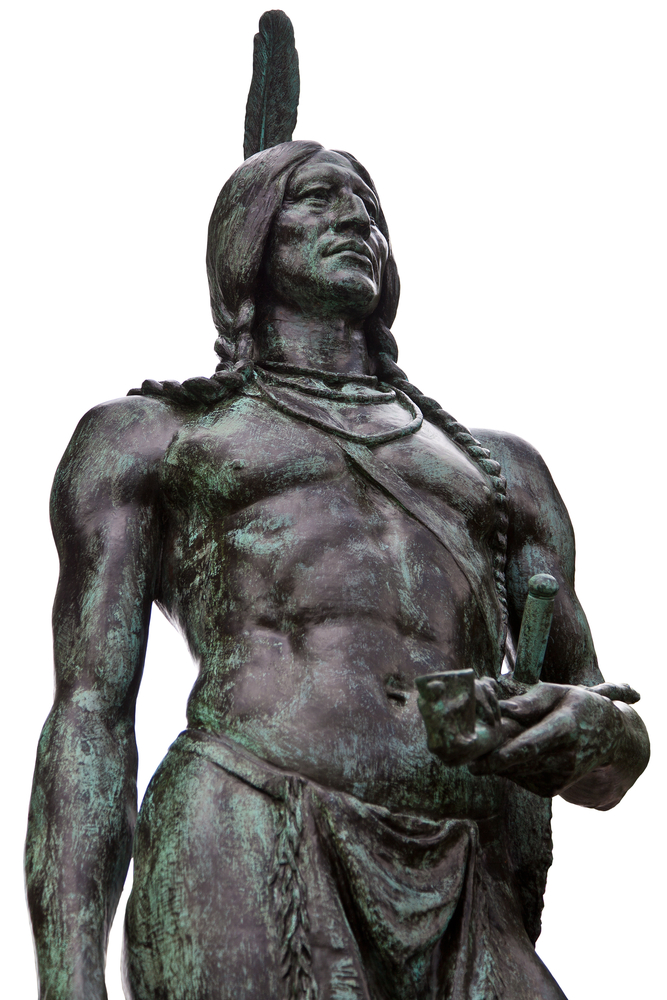
The statue of Ousamequin that stands on land he would have once ruled over today
One of the first to greet him was Edward Winslow , originally from Worcestershire. A leader in the Separatist group and a skilful diplomat, Winslow had not only been instrumental in organising the journey to America, but was also one of the men who signed the historic Mayflower Compact.
The Wampanoag were wary of the nearby Narragansett tribe, who had not been affected by the disease epidemics and remained a powerful tribe.
They demanded that the Wampanoag show them honour and tribute. Ousamequin would have known an alliance with these new English colonists might help fend off any attacks from the Narragansett.
In 1621, the Narragansett sent the Plymouth colony a threat of arrows wrapped up in snake skin. William Bradford, who was governor of the colony at the time, filled the snake skin with powder and bullets and sent it back.
The Narragansett knew what this message meant, and would not attack the colony.
Ousamequin and The Pilgrims established an historic peace treaty and the Wampanoag went on to teach them how to hunt, plant crops and how to get the best of their harvest, saving the Pilgrims from starvation.
It is believed that Winslow was even able to help nurse Ousamequin back to health when he fell ill, reportedly using his renowned chicken soup and strengthening their relationship further.
The first Thanksgiving
Success followed and following a bumper harvest in the autumn of 1621, the colonists decided to celebrate with a three-day festival of prayer.
The 53 surviving settlers invited their Native Americans friends to join them for a huge feast in what was to become known as the first Thanksgiving.
One of two first-hand accounts of this celebration was contained in the book Mourt’s Relation, primarily written by Winslow. The book describes in detail what happened from the landing of the Mayflower Pilgrims right through to this celebratory feast.
Winslow’s account states:
“Our corn did prove well, and God be praised, we had a good increase of Indian corn, and our barley indifferent good, but our peas not worth gathering, for we feared they were too late sown. They came up very well, and blossomed, but the sun parched them in the blossom. Our harvest being gotten in, our governor sent four men on fowling, that so we might after a special manner rejoice together, after we had gathered the fruits of our labors; they four in one day killed as much fowl, as with a little help beside, served the company almost a week, at which time amongst other recreations, we exercised our arms, many of the Indians coming amongst us, and amongst the rest their greatest king Massasoit, with some ninety men, whom for three days we entertained and feasted, and they went out and killed five deer, which they brought to the plantation and bestowed on our Governor, and upon the Captain and others. And although it be not always so plentiful, as it was at this time with us, yet by the goodness of God, we are so far from want, that we often wish you partakers of our plenty.”
Today, the US celebrates Thanksgiving on the fourth Thursday of November.
The impact of colonisation
The repressive church rule in England would drive more people to follow the Mayflower to America. Another ship arrived in 1621 and two more in 1623.
In 1630, 1,000 Puritans arrived under Governor John Winthrop under a charter from by the Massachusetts Bay Company. Winthrop soon established Boston as the capital of Massachusetts Bay Colony, and it would soon grow into the biggest colony in the area.
These Puritans wanted to free themselves of the Church of England and ‘purify’ it from Roman Catholic practices.
They arrived under the guise of creating a perfect city – but ended up creating a society just as intolerant. Quakers were persecuted with public hangings and whippings.
Tensions between these colonists and the Native American people rose. The colonists brought more disease to which the Native Americans would have no immunity. Smallpox would ravage communities still recovering from the Great Dying. Violence increased.
By the 1630s, the Native Americans in this region were in the minority in their own lands and wars such as the brutal Pequot War reduced the population significantly.
By 1676 Boston was an economically flourishing town with a population of about 4,000 and had established itself as the dominant force.
King Philip's War
The carefully managed peace that had originated between the Wampanoag and the Plymouth colony was eventually shattered by King Philip’s War in 1675.
When Ousamequin died in 1662 his son and heir Metacom no longer believed in the value of the alliance with the colonists. The collapse of trade agreements and the aggressive expansion of the colonies left relations at breaking point.
Tensions were raised when the colonists demanded the peace agreement should mean the Wampanoag hand over any guns, and hung three of the tribe for murder in 1675.
Metacom - who was known as King Philip by the English - led an uprising of Wampanoag, Nipmuck, Pocumtuck and Narragansett tribes. They came up against the biggest army the c olonial leaders could muster, that fought in coalition with other tribes.
The war is seen as a final attempt to drive out the colonists and lasted 14 months. It is considered the deadliest war in American history.
The colonist army burned villages as they went and by the end of the war, the Wampanoag and their Narragansett allies were almost completely destroyed. Metacom fled to Mount Hope where he was finally killed by the militia.
This war was fought by colonists without support from England or any other European government and is often seen as the moment a new American identity was formed.
The fate of the Plymouth colony
Eventually the likes of Brewster and Winslow went on to found their own communities and the colony began to struggle. The cost of the war did not help and after a colonial governor was appointed to rule over New England in 1692, Plymouth was absorbed into Massachusetts.
The term Pilgrim originated in 1820, when during the 200 th commemoration of the colony’s landing they were referred to as the Pilgrim Fathers in reference to Bradford’s manuscript where he names passengers on the boat from Leiden ‘saints’ and ‘pilgrimes’. The phrase was coined.
Modern Response
The Native American activist group, The United American Indians of New England, continues to raise awareness of racism towards Native Americans and the consequences of colonialism. When the Wampanoag leader, Frank James, was informed that his speech was inappropriate and inflammatory for the annual Thanksgiving ceremony 1970, he refused to read their revised speech.
Supporters followed James to hear him give his original speech on Cole’s Hill, next to the statue of Ousamequin. This became the first National Day of Mourning, which continues today in Plymouth, Massachusetts, on the same day as Thanksgiving.
Also in this section
- Travel Trade
Sign up for the latest Mayflower 400 news
You'll be the first to hear the latest Mayflower news, events, and more.
Forgotten Password?
Mayflower 400 Proudly Supported by our National Sponsors and Funding Partners

- Website Privacy Policy
MayflowerHistory.com

The Mayflower
Plymouth colony.
- History of the ship Mayflower
- The Mayflower 's Voyage
- The Mayflower 's Crew
- Inside the Mayflower : Cross-sections
- What did they bring? Provision lists
- Women on the Mayflower
- Girls on the Mayflower
- The End of the Mayflower
- Fort, Militia, and Weapons
- Animals and Livestock
- Cooking and Food
- Crime and Punishment
The Wampanoag
Miscellaneous topics.
- Brief History of the Wampanoag
- Tisquantum ("Squanto")
- Massasoit Ousemequin
- Wampanoag Language
- Religious Beliefs of the Pilgrims
- History of the Thanksgiving Holiday
- Clothing of the Pilgrims
- Visiting Modern-Day Plymouth

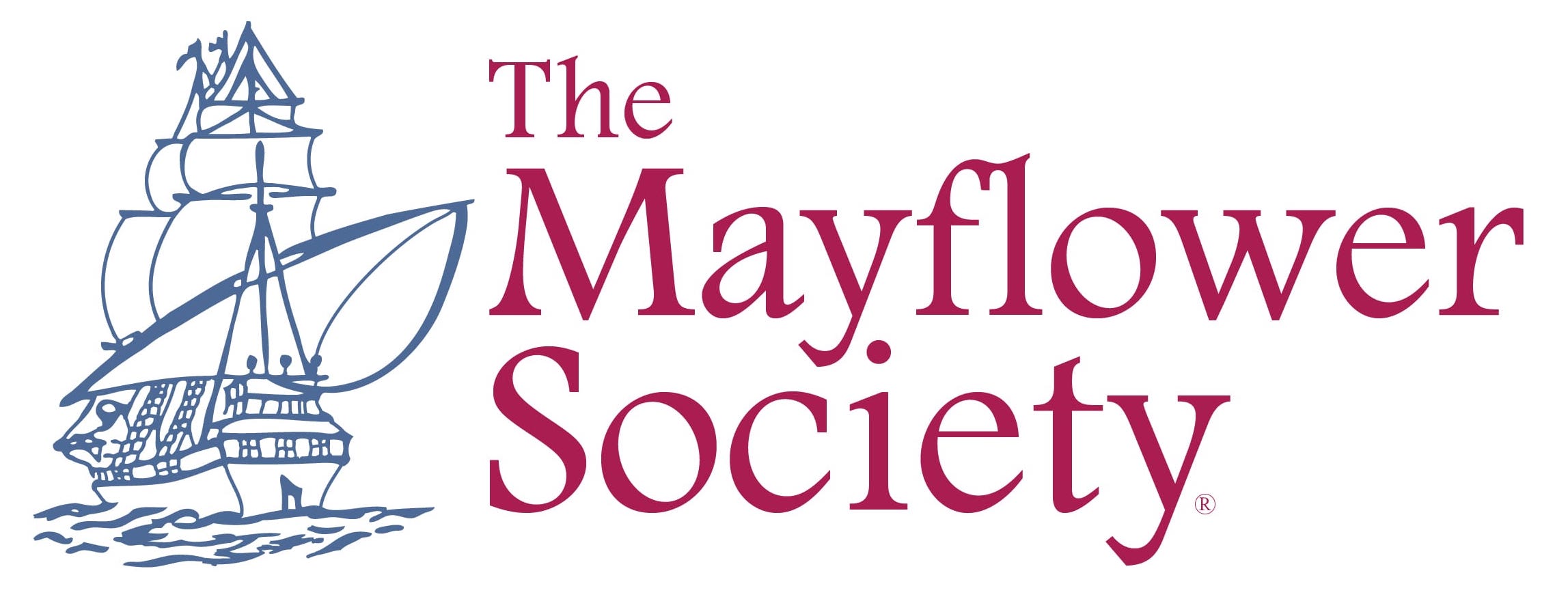
The Mayflower Voyage
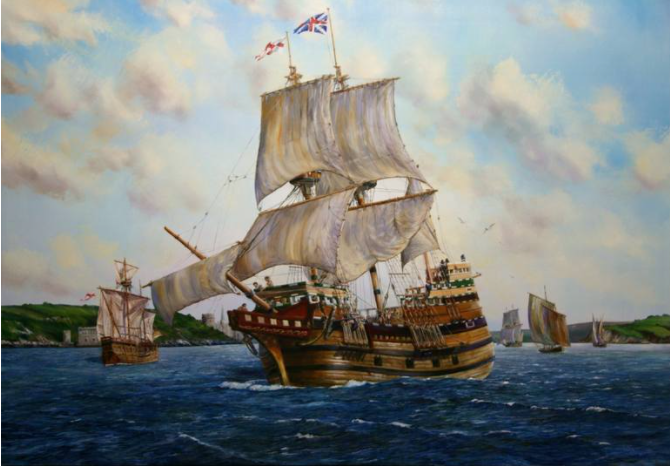
It is hard for us in this present age to imagine what it would be like not to know certain things – not know how wide the oceans were; – not to know how far Virginia was from Plymouth, England; – or from Plymouth, Massachusetts, for that matter; not to know, even, how far a ship would sail in a day or a week, and not to have any maps or charts of a good degree of accuracy for any country or any ocean on earth. All of this lack of knowledge was the situation 1620.
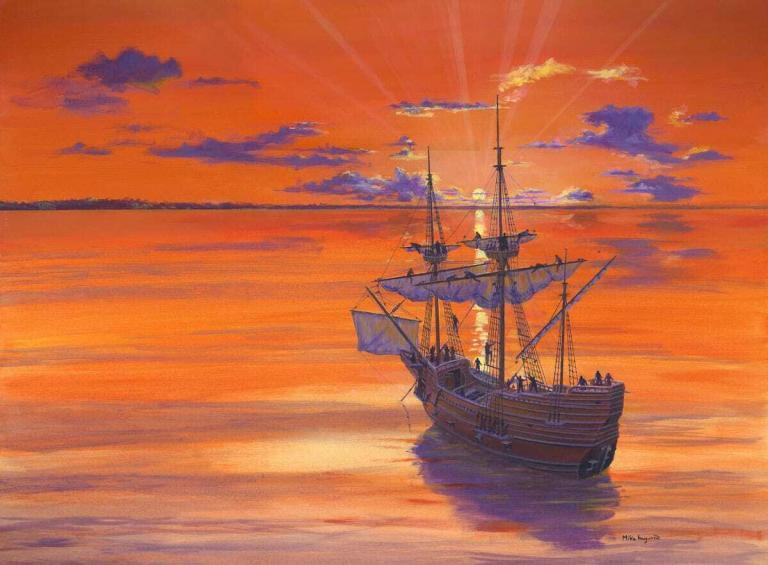
Now, of course, there was much sea-faring in 1620. Ships plied the English Channel, sailed up and down the coast of France and Spain and swarmed all over the Mediterranean. But this was mainly coastal, short voyage work. In any trip the length of time out sight of land was minimal. This is not to say that there were not trans-ocean voyages in the period. The gold trade between Spain and Mexico had flourished for years. The cost in lives and ships and cargo had been and continued to be terrific. The many recent treasure finds from sunken Spanish galleons in waters near Florida bear vivid witness to the awful costs of these many passages. These costs in men, ships and cargo were due in great degree to the ignorance of the crews and skippers and navigators. In those days the practitioners of the sea-faring art had no ability to determine accurately, on a day to day basis, their ship’s position or what dangers lurked.
So much for the state of the art in 1620. What do we find as to how many of these meager skills were possessed by Captain Jones and his crew aboard the Mayflower?
We know that Captain Jones was a part owner of the ship and had been Captain for several years. He had just returned from Spain, hauling a cargo of wine. He had traded at least once across the North Sea to Norway from Newcastle. He was probably as well suited to, and trained for, an Atlantic crossing as the average sea captain of the day. To understand just what is involved in making a crossing, whether back then or today, it is necessary to get a bit technical and describe some of the essentials of navigation and passage making in any age.
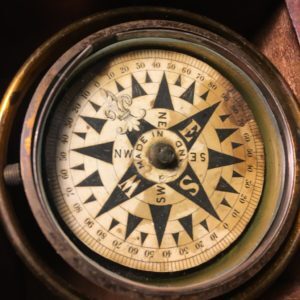
When out of sight of land, the navigator depends on several aids to keep his ship on course and to position her daily on the surface of the ocean. Then, as now, the first aid is the compass. With it he can shape his course steadily toward his destination. All of us know something about a compass, and how its north-seeking needle points to magnetic north. The discovery and use of the magnetic properties of ferrous compounds goes way, way back in time. One of the first references to a mariner’s compass is found in the writings of one Alexander Neckam, born in A.D. 1157. We are sure its use antedated this date by years and perhaps centuries.
The next aid is the traverse board . This is a kind of abacus and memo pad. A circle at the top of the board is divided by radii into the thirty-two points of the compass. Each of these radii has eight holes, evenly spaced out from the center, into which pegs can be fitted. The bottom of the board is divided by eight horizontal lines and these lines also have holes evenly spaced across their length for pegs. Then, as now, a steering watch was four hours long, divided into eight 30 minute glasses of time. At the turning of each glass (every thirty minutes), the quartermaster put a peg in the proper radius hole to represent the average course steered during the period and the proper glass number of the watch period.
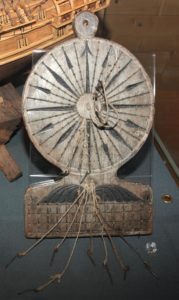
This sounds quite impressive, but the results were far from anything but rough guesses. They were at least better than no guess at all. So, with compass, traverse board and log-ship, the 1620 navigator kept his accompt book of daily positions – his dead reckoning positions. Even today, with much better compass, perfect timing devices, and excellent speedometers, the position of a ship at sea by dead reckoning may be off by a substantial mileage each day.
This leads us to the next aid the navigator must have. He must have a way of figuring his position from day to day by means independent of course or speed. The aid he uses to do this is an altitude measuring device with which he can determine the altitude of some heavenly body and, with suitable calculations, find from this measurement his location at sea. In 1620 the aids used were either an astrolabe or a Davis backstaff .
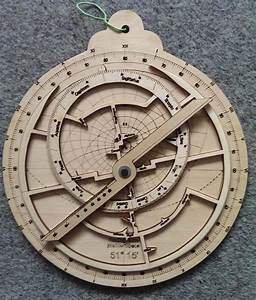
This is where Celestial Navigation comes into the picture. Celestial Navigation, in all its mathematical and astronomical theory, is rather complicated but its basic principal is simplicity itself. Poets have referred to the heavenly bodies – the sun, moon, stars and planets – as the “Lighthouses of the Sky” This poetic fancy happens to be strict, practical fact. Consider for a moment. We are on the revolving earth. It revolves from west to east, and this motion makes it appear to us that the sun and all other bodies rise in the East and set in the West. Imagine, if you will, a string running from the center of the earth to the center of a heavenly body. This string would cut the surface of the earth at a certain point at a certain time. This point is called the “GP” of the body. “GP” stands for “geographical position.” It keeps changing from moment to moment as the earth turns. Today the GP’s of fifty-seven navigational stars, four planets, the moon and the sun are listed in a Government publication issued annually and called the Nautical Almanac. This book lists these positions in terms of degrees North or South of the equator, and degrees West of an arbitrary line running through Greenwich, England. They are listed for every second of time of the year.
In 1620 no such handy volume existed. Tables of the “Declination of the Sun” for every day of the year were available, however. Declination is merely the astronomer’s name for latitude and refers to the latitude on the earth’s surface of the GP of the body. Now, remember a heavenly body moves westward in the sky rapidly, about 15 degrees an hour, but it moves slowly north or south. So a daily table of the sun’s declination is useful.
Let’s review a bit now. The aids available to Captain Jones in 1620 were the compass , the traverse board , the log ship and, of course, the second glass and hourglass. With these he did the best he could to keep his accompt book , or Log of daily dead reckoning position – his “DR.” He used his Davis backstaff or astrolabe to measure the altitude of the sun. Today he would use a sextant. This beautifully accurate instrument in the hands of a skilled observer is capable of measuring altitude angles to one six-hundredth of a degree. Captain Jones with his instrument would do well to get within a degree – some six hundred times less accurate – on board the heaving and pitching Mayflower !
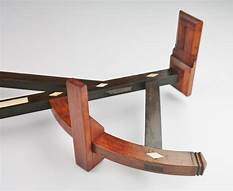
To do his best to keep from building up high cumulative errors in his dead reckoning accompt , Captain Jones practiced celestial navigation each day at high noon. High noon merely means that the sun is due north or due south of you, and is going from “rising” to “setting.” At this moment we say it is on your meridian – not A.M. or P.M. Captain Jones’s celestial navigation consisted of measuring the sun’s altitude at his best estimate of its highest point for the day.
This high point occurs at high noon (by a sun dial or compass). To make this measurement, the backstaff was probably used because it was a bit simpler on shipboard than an astrolabe. From the altitude of the sun, so obtained, and the declination for the day from the tables, Captain Jones could get his latitude by a simple calculation. We might mention here that Captain Allan Villiers carried a replica of a Davis backstaff on the voyage of Mayflower II and reported it quite useless for any meaningful accuracy. Even allowing Jones much greater accuracy than Villiers, due to more practice, it is doubtful if the latitudes obtained were much better than the DR figures which themselves were pretty awful by present day standards.
Now note that this bit of celestial observation only checked latitude. No attempt to obtain positions East or West of your departure was possible by celestial observations at that time. It would be more than a hundred years later before longitude could be found at sea.
We have mentioned the sun only as a method to obtain latitude. For centuries navigators had known that the altitude of the Pole Star, Polaris, roughly equaled the latitude of the observer. At the time of the Mayflower voyage, it is likely that Captain Jones felt he could get better results from observations of the sun. Of course, he might have observed either from time to time.
There is a whole set of circumstances in seventeenth century sailing which must not be overlooked. We must remember the life aboard a ship at those times– the almost unbelievable discomfort, the monotony, week after week after week, the cold, the wet, the poor food coupled with hard physical labor. This terrible environment made it practically impossible to exercise the careful judgment and carry out the accurate calculations which, then as now, are absolutely essential in the practice of navigation. There is no wonder that whole fleets of ships were sunk and wrecked on unfamiliar shores, and that a seaman’s life was hard and short in those far off times.
The Mayflower made history by carrying the Pilgrims to the New World. But never forget – SHE WAS ONE OF THE LUCKY ONES!
– November 1980 – VoL 46 No. 4

Trailing the Mayflower - The Iconic Ship of a Pilgrim Voyage to the New World
- Read Later
One of the most famous voyages from England to Virginia was on the Mayflower. This ship became the symbol of the search for a new life and pilgrimage to the New World in the 17th century. 2020 marks the 400 year anniversary of this historic vessel’s iconic voyage.
The origins of the Mayflower are uncertain however it is known that the ship was bought around 1607 by Christopher Jones and his business partners. The first well-documented voyage of the ship happened in 1609. The destination was Trondheim in Norway. It was hired by Andrew Pawling to take cargo from London to Norway. The crew was also instructed to buy tar, fish, and lumber and bring it back to England. Unfortunately, the crew lost most of the goods during a storm. After this situation, the Mayflower traveled for the same purposes to France, Spain, and Germany.
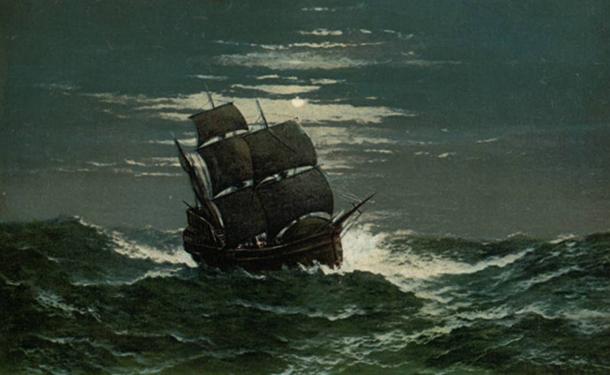
The Mayflower at sea. ( Public Domain )
The Mayflower was a classic merchant ship built in the 17th century. It was square-rigged, beak-bowed, and could travel with 180 tons of cargo. It measured about 100 feet (30.5 m) in length and 25 feet (7.5 m) at its widest point. The Mayflower wasn't created to sail on the ocean and it didn't sail well against the wind. But when Jones and his crew returned from Bordeaux, France, in May 1620, they were hired for a special voyage…
The Mayflower’s Voyage into the Unknown
The Mayflower started its legendary voyage from Plymouth to the New World in September 1620. Apart from a crew of around 30 people, there were 102 passengers on the ship. The pilgrims paid Jones to take them to northern Virginia.
Jones was a 50-year-old man from Essex, England. He was a sea veteran who valued money and freedom. He appreciated his lifestyle as a sailor, and did not treat the travel to Virginia as anything more than another job.
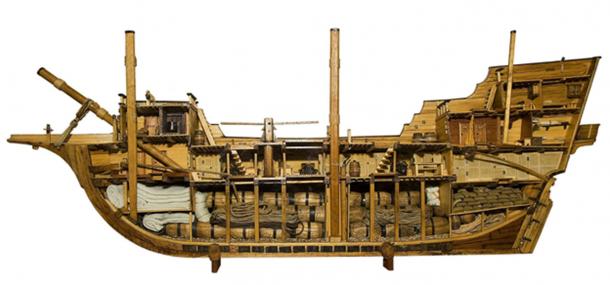
Model of a typical merchantman of the period, showing the cramped conditions that had to be endured. ( CC BY-SA 3.0 )
The men, women, children, and animals on the Mayflower faced the same difficulties as others who made the voyage across the Atlantic Ocean during the times of the colonization of North America. Jones had never been in the New World before, but some of his co-workers, like Robert Coppin and John Clarke (the master mates), had been there before. The passengers were not ready for the cold and other weather conditions and they suffered from tuberculosis, pneumonia, and scurvy . Two passengers died and a baby girl named Oceanus was born at sea.
- The American Tradition of Thanksgiving: A Harvest Festival with Roots in the Old World
- Would you take a Medieval Journey? Man recreates Pilgrimage across England with period supplies only
The Mayflower arrived in the New World a few weeks after it left England. The crew reported on November 9, 1620, that they sighted land in the area which is currently known as Cape Cod. The ship went back to England in April 1621. It left a group of people behind, who were not the first settlers on the continent, but they did create a few iconic symbols for the future United States of America.
A New Home in Virginia
The pilgrims created Plymouth Colony, supported with an agreement signed in 1620. It was the main legal instrument to confirm the arrival and creation of new settlements in New England . The text of the Mayflower Compact was published on November 11, 1620, but it received its name in 1793. The document, written by the new inhabitants of New Virginia, became the basis for the future Declaration of Independence and constitution of the USA. The document stated:
''In the name of God, Amen. We whose names are underwritten, the loyal subjects of our dread Sovereign Lord King James, by the Grace of God of Great Britain, France, and Ireland King, Defender of the Faith, etc. Having undertaken for the Glory of God and advancement of the Christian Faith and Honour of our King and Country, a Voyage to plant the First Colony in the Northern Parts of Virginia, do by these presents solemnly and mutually in the presence of God and one of another, Covenant and Combine ourselves together in a Civil Body Politic, for our better ordering and preservation and furtherance of the ends aforesaid; and by virtue hereof to enact, constitute and frame such just and equal Laws, Ordinances, Acts, Constitutions and Offices from time to time, as shall be thought most meet and convenient for the general good of the Colony, unto which we promise all due submission and obedience. In witness whereof we have hereunder subscribed our names at Cape Cod, the 11th of November, in the year of the reign of our Sovereign Lord King James, of England, France and Ireland the eighteenth, and of Scotland the fifty-fourth. Anno Domini 1620.''
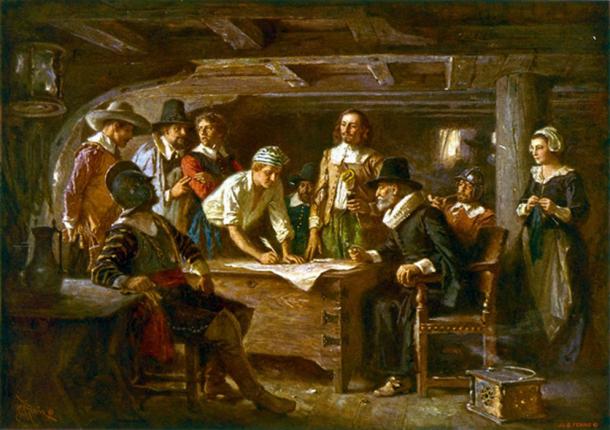
Signing the Mayflower Compact 1620, a painting by Jean Leon Gerome Ferris 1899. ( Public Domain )
Apart from their defensive fort, houses, and community storehouses, the people who arrived in northern Virginia also built a meetinghouse to hold their church services, court sessions, and town meetings. In 1621, the colonists of Plymouth celebrated the holiday Thanksgiving , which was a harvest feast after a good growing season. A previous Ancient Origins article describes how vital the Pokanoket tribe were to that day:
The Pokanoket tribe, as the Wampanoag nation was also known, saved the Mayflower Pilgrims from starvation in 1620-’21 despite apprehension they felt because of violence by other explorers earlier in history. But early on the Pilgrims made a peace pact with the Pokanoket, who were led by Chief Massasoit. One Indian, Tisquantum or Squanto could speak English. He and his people taught the Pilgrims what they needed to know about farming in the area that became known as New England. In November 1621 the natives and Pilgrims celebrated what we call Thanksgiving.
The Ship’s Significance
In 1622, Jones died of a mysterious disease which he had contracted in the New World. He is buried at St Mary’s Church in Rotherhithe, London, England. The Mayflower awaited a new fate for the next two years. However, it was considered an old ship and not useful, so it was either taken apart and used as timber to build a barn, or rebuilt into a new ship.
- The Columbus Myth
- Walking the footsteps of ancestors, the ancient pilgrimage of Camino de Santiago
Nevertheless, the legend of the Mayflower was already very strong, so the English built a new ship with the same name. It brought 35 passengers from London to the colony in Plymouth in 1629 and it transported passengers between the two continents until about 1642. Pilgrim journeys to America started in 1608, but the Mayflower's passengers made one of the biggest impacts on the new society, and opened a new chapter in history.
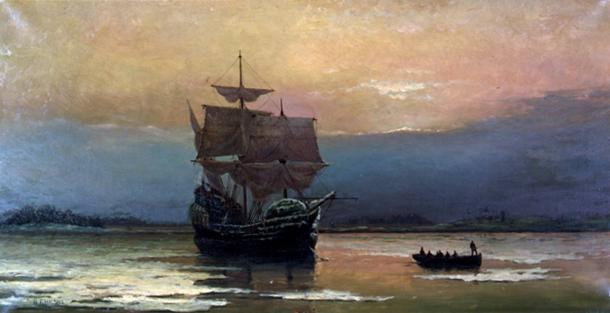
Mayflower in Plymouth Harbor by William Halsall (1882). ( Public Domain )
A Challenging Legacy: Mayflower 400
In 2020, the Wampanoag , United States of America, Netherlands, and the United Kingdom have been commemorating the 400th anniversary of the Mayflower's famous voyage. The nations had planned many exciting events for Mayflower 400, however several programs have had to be changed, conducted online, cancelled, or postponed due to the current pandemic. One of the ambitious projects that has been completed is the Virtual Mayflower project – a VR model of the Mayflower ship.
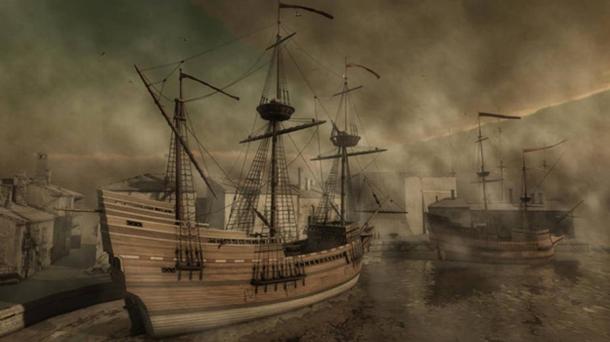
An image showing early VR models of the Mayflower and Speedwell. The Speedwell was left behind in Sutton Pool after two attempts to make the transatlantic crossing failed. ( HIT Team, University of Birmingham )
According to the Mayflower 400 website, the main goal is “an honest, broad and inclusive commemoration of the ship’s sailing from England to America and its often challenging legacy.” The project leaders are exploring themes of migration, humanity, oppression, persecution, loss, and freedom. Despite the setbacks, Mayflower 400 is still underway and will continue into 2021.
Top Image: Mayflower II – this is a replica of the 17th century Mayflower ship. Source: Jim Curran /Adobe Stock
By Natalia Klimczak
Updated on November 24, 2020.
References:
Nathaniel Philbrick, Mayflower: A Story of Courage, Community and War, 2006.
www.history.com/topics/thanksgiving/history-of-thanksgiving
https://www.themayflowersociety.org/
http://www.perseus.tufts.edu/hopper/text?doc=Perseus%3Atext%3A2005.05.0026%3Achapter%3D2
http://mayflowerhistory.com/voyage/
www.mayflower400uk.com
http://www.history.com/topics/mayflower
http://www.plimoth.org/learn/just-kids/homework-help/mayflower-and-mayflower-compact
All I can say about Mayflower & Thanksgiving is at least they finally taught The Real History of Mayflower & The Wampanoag People.
I think what amazed me is the pilgrims came to New Canaan I'm surprised Plymouth Massachusetts wasn't renamed Canaan to begin with for Freedom of Religion experiencing Intolerance from England; only too come to The New World and return that same intolerance to Indigenous Tribe's, and Quakers.
I'm serious I watched this Finding your Root's episode and a few people on this program Dr. Gates and his Team traced; all the way back too The Puritans right in the middle of the 1600's, before we're known as America.
A relative participating on the show discovered that their great-grandfather was arrested and tried for giving shelter to some Quakers. It was nighttime and so Storming really bad I'm talking thunder & lighting, downpour at night before the day street lamps existed not too mention the bitter cold.
The Quakers knocked on his Door for shelter from The Storm He the Puritan Christian opened that Door and gave shelter to the Quakers in that awful Storm.
The Puritan Man wound up going to jail for giving shelter to the Quakers during a Storm; that's when Dr. Gates explained that back in England that the Puritans fled from King James had Quakers Executed it seems Hate towards The Quakers came with The Puritans it's shocking really.
The man wound up being excommunicated from The Puritan Community The Quakers he show Christian Love too? They took Him in and traveled elsewhere in Massachusetts to a place that became Quaker Capital, of The State of Massachuettes as for the Excommunicated Puritan wouldn't you know He became Quaker.
The Quaker Capital would become an economic goldmine in the long run The Whaling Industry would start there.
This is what I think of when reading up on history of The Pilgrims and strain relations with The Indigenous Tribes in general.
Time for me too go so until next time Everyone, Goodbye!
This article has a number of problems that maybe they don’t teach in grade school anymore: 1. There were only two deaths on the journey– a crewman (who had been at odds with the Pilgrims and was “struck down by God”) and William Bradford’s wife, who “fell” off the boat at anchorage where Provincetown is now, so she actually survived the journey. The deaths came about because of the harsh winter and lack of supplies; as Caroline noted above, the Mayflower could not carry all their needs – the Speedwell was supposed to bring more. The French seizure/blockade of English ships during the siege of LaRochelle also put strains on the supply of the colony (see Comment 5). 2. The Pilgrims did not start a “Church of England”. They were Separatists and wanted to worship separately from the Church of England. 3. My understanding is that Christopher Jones died in the New World, either in 1621 or on a later voyage, not in France. 4. About 20 years ago, maybe more, there were news articles (e.g., Newsweek) that someone had supposedly discovered the remains of the Mayflower incorporated into a barn in Kent or elsewhere in southern England. 5. An additional reference that might be useful is “Making Haste from Babylon” (sorry, don’t recall author except that he was English) which came out about the same time as Philbrick’s book, which I have not read yet.
I find it hard to believe the Mayflower was only 25feet wide. I had a garage that was on a piece of fenced property that was 35feet wide and 100feet deep and your telling me the Mayflower was ten feet narrower and held all those people, food and belongings? I don't think so!
Natalia Klimczak is an historian, journalist and writer and is currently a Ph.D. Candidate at the Faculty of Languages, University of Gdansk. Natalia does research in Narratology, Historiography, History of Galicia (Spain) and Ancient History of Egypt, Rome and Celts. She... Read More

Related Articles on Ancient-Origins
History for Kids
Mayflower Facts for Kids
Table of Contents
- In September 1620, a ship from England called the Mayflower set sail.
- It usually carried wine and other goods, but this time it had 102 passengers who wanted to start a new life in the New World.
- Nearly 40 of these passengers were Protestant Protestants that we call today “Saints.”
- They wanted to have their church in the New World.
Who were the Mayflower Pilgrims?
In 1608, a group of people from England went to Holland. They were angry at how the Church of England was. People did not want to be part of it because they thought it was almost as bad as the Catholic Church. Keep reading to learn more Mayflower facts.
The Separatists were not the same as the Puritans. The Puritans wanted to reform the Church of England, but Separatists wished to separate themselves from it. They went to Holland thinking that they would be free there.
Separatists, or “Saints,” found religious freedom in Holland. But they also found it challenging to live in Holland because Dutch guilds excluded migrants. They were only allowed to have jobs where they made little money.
Some of the children of the Separatists were not happy with Holland. They had a hard time, and they didn’t like it.
The Separatists were very strict and devout. People decide to move away from the government or worldly things. They went across the ocean to America, which they called “the New World.”
The people who founded the Plymouth Colony called themselves “Saints,” not “Pilgrims.” But for some reason, no one used the word “Pilgrim” to describe this group until after they had lived there for 200 years.
Financing the Voyage
Profit-seeking corporations set out to establish colonies in America. Investors wanted people who were close, diligent, and knew how to work hard. The Pilgrims fit these qualities well.
After the Pilgrims received a license from the Virginia Company to establish a colony in their region, 70 merchants in London known as the Merchant Adventurers contributed money. They invested in the firm. These individuals paid for the Mayflower , her crew, and food for a year.
The Merchant Adventurers wanted to profit; therefore, they made the Pilgrims work for the firm for their first seven years in America. For coming to America and working, each colonist over the age of 16 was given one share of stock. They were free to keep the stock if they worked hard.
The Pilgrims needed to take on new people to help pay for the voyage. They took on other people who wanted commercial success, but they did not share their beliefs.
These “strangers” (as the Pilgrims called them) were half of the people on the Mayflower . When they landed in Massachusetts, they argued about making their own rules and not following those from Virginia. The Pilgrims made a group and wrote the Mayflower Compact, a document to set regulations for self-government and prevent them from rebelling.
The Mayflower Crossing
The Mayflower sailed on September 16th, 1620, from Plymouth in Great Britain. The ship went to America.
More than 30 million people can trace their ancestry back to the 102 passengers and approximately 30 crew aboard the Mayflower when it landed in Plymouth Bay, Massachusetts. It was a cold winter.
The Pilgrims were not the first to land in America. There were already other colonies here. One of these is Jamestown. It was founded in 1607.
Pilgrims thought that Virginia in America was an excellent place to live because people had already settled there. But they didn’t want to settle too close and create the same environment.
Some of the people on board on the Mayflower were John Alden, Isaac and Mary (Norris) Allerton, Bartholomew, Remember, and Mary John Allerton. Onboard were also William Bradford and his wife Dorothy (May) Brewster. They had their children Love and Wrestling. There was also Richard Britteridge’s family with Peter Browne.
The Mayflower took 66 days to cross the Atlantic. The voyage was so bad that people could not stand up, and they only had little power because of many storms.
Sometimes, they just drifted rather than using their sails. One person was swept overboard. A woman named Elizabeth Hopkins gave birth to a baby boy who was given the name Oceanus.
Arrival in America
The Pilgrims had planned to land in Virginia and the Hudson River (today New York). They had heard good things about it. The Mayflower missed the Hudson River by some degrees.
The Pilgrims sailed towards land. They saw the cape on November 9th at sunrise. The Pilgrims decided to make their plantation in New York because it had a good river with many fish.
But the rough seas almost shipwrecked the Mayflower, and they decided to stay and explore Cape Cod rather than risk another journey south. They anchored in what is now Provincetown Harbor.
A woman named Susannah White gave birth to a baby boy aboard the Mayflower . He was the first English child that was born in the colony. His name ended up being Peregrine. He was named after a traveler (a pilgrim).
The Mayflower Compact
The colonists knew they were not allowed to live in the land they came to, so they drew up a document that would make them seem like they had some legal standing. On this document, called the Mayflower Compact, the settlers on the Mayflower agreed to cooperate.
They also agreed that they would deal with issues by voting and establish constitutional law. The law would be based on what more people wanted.
In this document, they talked about how they wanted to have a government in the new world. They wanted a body politic and laws that were just and equal.
They also promised to be loyal to the English king. It was the first document in America that talked about democracy because it set an example for people trying to get away from being ruled by the British later on.
Plymouth Colony
After 66 days, the Mayflower reached Cape Cod Bay. They landed on the site of Provincetown on November 21. They sent an exploratory party ashore and docked at Plymouth Rock 18 days later.
The explorer John Smith named the area Plymouth after leaving Jamestown, a permanent English settlement in the New World. The settlers agreed that the name was appropriate because the Mayflower had been from Plymouth, England.
Some settlers stayed onboard the Mayflower for a few months. They would go to shore and then back again to build their new settlement.
In March, they began to move ashore and build their homes permanently. More than half of the settlers became sick and died that first winter because of an epidemic that swept through the colony.
The Pilgrims, soon after they landed, met a Native American man. His name was Tisquantum or Squanto. He became a member of the colony too.
John Smith captured a member of the Pawtuxet tribe and took him to England. This man, Squanto, escaped back to his homeland. He acted as an interpreter between Plymouth’s leaders and the Pokanoket tribe’s leaders.
English-speaking Samoset helped the colonists ally with the local Wampanoags. They showed them how to hunt, gather food, and grow vegetables.
Read more about Plymouth Colony
A Love Triangle
In 1620, John Alden went on the Mayflower voyage. He was hired to be a cooper (barrel maker) on the ship. Myles Standish also joined the trip for his military experience. When the ship got back to England, John and Myles decided to stay in Plymouth Colony rather than go home.
Priscilla Mullins started on the voyage with her father, stepmother, and brother. It was a challenging year for Plymouth. It had been tough before, but then tragedy struck, and Priscilla lost her whole family.
John Alden and Priscilla Mullins are amongst the colony’s first couples to marry. According to folklore, John Alden and Myles Standish have sworn enemies. This is why the well-known poem The Courtship of Miles Standish was written.
In the poem, Myles has a crush on Priscilla. He wanted to tell her, but he was too shy, so he asked John to say to her for him. Priscilla liked John more than Myles, so she started going out with John instead of Myles.
Though there is not much information about John Alden and Priscilla Mullin’s courtship, we know a lot about their lives and legacy. John Alden was an active member of the Plymouth Colony.
He signed the Mayflower Compact. He also served in many different jobs, including treasurer, court deputy, and governor’s assistant.
John and Priscilla received 100 acres in Duxbury. They built a house and farm on the property.
The family traveled 10 miles to Sunday church services in Plymouth for many years. So, they started another congregation in Duxbury that became a separate town in 1637.
John and Priscilla had 10 children together and were both founding members of Duxbury. They had more descendants than any other Mayflower passengers.
The First Thanksgiving
In 1621, the Pilgrims and the Pokanokets had a feast. It was a big meal for three days. They played games too. The feast is now called Thanksgiving because it happens in Fall.
On the first Thanksgiving, most of the people were men. 78 percent of the women who traveled on the Mayflower died over winter. Of 50 colonists who celebrated the harvest, 22 were men, four were married women, and 25 were children and teenagers.
The Pilgrims were outnumbered by the Native Americans. They had to have been scared because there were more Native Americans than Pilgrims. But they also knew that they wanted to live in peace so that they could talk with them.
Read more about The Pilgrims
More Ships Arrive
The Mayflower was the first ship to come to Plymouth. Three more vessels came after it, including the Fortune , Anne , and Little James . The people on the first four ships were called “Old Comers” because they came to Plymouth before everyone else. They were given special treatment in later colonial affairs.
The Pilgrims first paid off their debt in 1648. They had a similar fate as many struggling businesses. The Plymouth Colony was eventually taken over by a larger, more successful company when it merged with other colonies to form the Province of Massachusetts Bay in 1691.
Still, even though there were other Christians in the world, the people from Mayflower and their descendants felt that God chose them to be a beacon for them. Bradford wrote that “as one small candle can light a thousand candles, so our light has shown to many people and in some ways even to our whole nation.”
- https://www.history.com/topics/colonial-america/mayflower
- http://mayflowerhistory.com/
- https://www.britannica.com/topic/Mayflower-ship
- https://www.mayflower400uk.org/education/the-mayflower-story/
- https://www.familysearch.org/blog/en/mayflower-pilgrims/
P.S. If you enjoyed what you read and are a teacher or tutor needing resources for your students from kindergarten all the way up to high school senior (or even adults!), check out our partner sites KidsKonnect , SchoolHistory , and HelpTeaching for hundreds of facts, worksheets, activities, quizzes, courses, and more!
- History Classics
- Your Profile
- Find History on Facebook (Opens in a new window)
- Find History on Twitter (Opens in a new window)
- Find History on YouTube (Opens in a new window)
- Find History on Instagram (Opens in a new window)
- Find History on TikTok (Opens in a new window)
- This Day In History
- History Podcasts
- History Vault
Mayflower Compact
By: History.com Editors
Updated: July 17, 2023 | Original: October 29, 2009

The Mayflower Compact was a set of rules for self-governance established by the English settlers who traveled to the New World on the Mayflower . When Pilgrims and other settlers set out on the ship for America in 1620, they intended to lay anchor in northern Virginia. But after treacherous shoals and storms drove their ship off course, the settlers landed in Massachusetts instead, near Cape Cod, outside of Virginia’s jurisdiction. Knowing life without laws could prove catastrophic, colonist leaders created the Mayflower Compact to ensure a functioning social structure would prevail.
Mutiny on the Mayflower
Of the 102 passengers on the Mayflower , there were 50 men, 19 women and 33 young adults and children. Just 41 were true Pilgrims, religious separatists seeking freedom from the Church of England .
The others were considered common folk and included merchants, craftsmen, indentured servants and orphaned children—the Pilgrims called them “strangers.”
Seeking the right to worship as they wished, the Pilgrims had signed a contract with the Virginia Company to settle on land near the Hudson River, which was then part of northern Virginia. The Virginia Company was a trading company chartered by King James I with the goal of colonizing parts of the eastern coast of the New World. London stockholders financed the Pilgrim’s voyage with the understanding they’d be repaid in profits from the new settlement.
But when the Mayflower landed in Massachusetts instead of Virginia, discord began before the colonists even left the ship. The strangers argued the Virginia Company contract was void. They felt since the Mayflower had landed outside of Virginia Company territory, they were no longer bound to the company’s charter.
The defiant strangers refused to recognize any rules since there was no official government over them. Pilgrim leader William Bradford later wrote, “several strangers made discontented and mutinous speeches.”
The Pilgrims knew if something wasn’t done quickly it could be every man, woman and family for themselves.
What Was the Mayflower Compact?
Pilgrim leaders wanted to quell the rebellion before it took hold. After all, establishing a New World colony would be difficult enough without dissent in the ranks. The Pilgrims knew they needed as many productive, law-abiding souls as possible to make the colony successful.
With that in mind, they set out to create a temporary set of laws for ruling themselves as per the majority agreement.
On November 11, 1620, 41 adult male colonists, including two indentured servants, signed the Mayflower Compact, although it wasn’t called that at the time.
Who Wrote the Mayflower Compact?
It’s unclear who wrote the Mayflower Compact, but the well-educated Separatist and pastor William Brewster is usually given credit.
One now-famous colonist who signed the Mayflower Compact was Myles Standish . He was an English military officer hired by the Pilgrims to accompany them to the New World to serve as a military leader for the colony. Standish played an important role in enforcing the new laws and protecting colonists against unfriendly Native Americans .
What Was the Purpose of the Mayflower Compact?
No one knows exactly what happened to the original Mayflower Compact. The accepted translation was found in William Bradford’s journal, Of Plymouth Plantation , in which he wrote about his experiences as a colonist.
The Mayflower Compact created laws for Mayflower Pilgrims and non-Pilgrims alike for the good of their new colony. It was a short document which established that:
The colonists would remain loyal subjects to King James, despite their need for self-governance .
- The colonists would create and enact “laws, ordinances, acts, constitutions and offices…” for the good of the colony, and abide by those laws .
- The colonists would create one society and work together to further it.
- T he colonists would live in accordance with the Christian faith .
Plymouth Colony
Once the colonists agreed to work together, the hard work of starting the colony began. They elected John Carver as governor on November 21, 1620.
Carver had helped secure financing for the Mayflower expedition and served in a leadership role during the voyage to America. He’s also sometimes given credit for helping write the Mayflower Compact.
Search parties then went ashore to find an ideal place to settle. They decided on Plymouth, where the colonists endured a brutal winter. Ravaged by starvation, disease and lack of shelter, more than half of the colonists died, yet Plymouth Colony survived.
It has been argued the Mayflower Compact’s role in cementing the colonists’ dedication to each other and their mission was critical to their endurance that first winter.
John Carver survived the hard winter of 1620 but died in April 1621, and the colonists chose William Bradford to replace him. Under his leadership, Plymouth Colony started to thrive.
As more and more settlers arrived and colonized the surrounding areas, a General Court was established. Each town elected representatives to attend the court, thereby creating an early representative government.
Why Was the Mayflower Compact Important?
The Mayflower Compact was important because it was the first document to establish self-government in the New World. It remained active until 1691 when Plymouth Colony became part of Massachusetts Bay Colony.
The Mayflower Compact was an early, successful attempt at democracy and undoubtedly played a role in future colonists seeking permanent independence from British rule and shaping the nation that eventually became the United States of America.
Text of The Mayflower Compact
The full text of the Mayflower Compact is as follows:
In the name of God, Amen. We, whose names are underwritten, the Loyal Subjects of our dread Sovereign Lord King James, by the Grace of God, of Great Britain, France, and Ireland, King, defender of the Faith, etc.:
Having undertaken, for the Glory of God, and advancements of the Christian faith, and the honor of our King and Country, a voyage to plant the first colony in the Northern parts of Virginia; do by these presents, solemnly and mutually, in the presence of God, and one another; covenant and combine ourselves together into a civil body politic; for our better ordering, and preservation and furtherance of the ends aforesaid; and by virtue hereof to enact, constitute, and frame, such just and equal laws, ordinances, acts, constitutions, and offices, from time to time, as shall be thought most meet and convenient for the general good of the colony; unto which we promise all due submission and obedience.
In witness whereof we have hereunto subscribed our names at Cape Cod the 11th of November, in the year of the reign of our dread Sovereign Lord King James, of England, France, and Ireland, the eighteenth, and of Scotland the fifty-fourth, 1620.
Featured Articles

How the Mayflower Compact Laid a Foundation for American Democracy
Pilgrims had to find a way to get along with "strangers" on their ship once they landed in the New World.

The Pilgrims' Miserable Journey Aboard the Mayflower
During their two-month journey to America, the Mayflower's passengers faced cramped quarters, rough seas, limited food and numbing cold.

What’s the Difference Between Puritans and Pilgrims?
Both sought a different religious practice than what the Church of England dictated, but they were otherwise distinct groups of people.
Mayflower Compact: 1620. The Avalon Project. Mayflower Compact: A Foundation for Our Constitution . ACLJ. Of Plymouth Plantation by William Bradford. HistoryofMassachusetts.org. The Plymouth Colony Archive Project . The Mayflower Compact. Constitutional Rights Foundation .

Sign up for Inside History
Get HISTORY’s most fascinating stories delivered to your inbox three times a week.
By submitting your information, you agree to receive emails from HISTORY and A+E Networks. You can opt out at any time. You must be 16 years or older and a resident of the United States.
More details : Privacy Notice | Terms of Use | Contact Us

Towers and wall of Donskoy Monastery to be repaired by Moscow city administration
Moscow, May 31, 2019
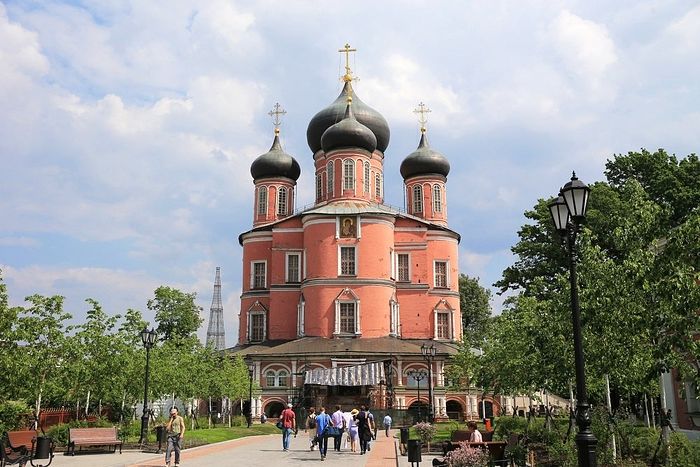
Several old towers and the wall of the famous Donskoy Monastery in Moscow will be restored, Mosocw mayor Sergei Sobyanin said after visiting the monastery and examining the architectural ensemble.
Funds will be allocated from the city budget for the restoration of 8 towers and 14 sections of the wall, reports Interfax-Religion .
“In Russia, there are not so many active monasteries that survived the Time of Troubles, the war with Napoleon, and the early Soviet years. One such historical monument is Donskoy Monastery. It is a pearl of Moscow. Our entire history is connected with,” the mayor said, reports the Synodal Department for Monasteries and Monasticism .
“The ensemble of the monastery is reviving,” said Sobyanin. “But there is still much to do. Restoration will continue with federal and regional funds, and with the donations of benefactors.”
“We just told Vladyka that in order to speed up the restoration of the walls and towers, the main cathedral, the city will actively help,” Sobyanin said after his visit to the monastery.
It is also notable that the people of Moscow themselves help with the restoration work. As Minister of Culture Vladimir Medinsky explained, people visit the monastery in their free time to offer their time and labor. Any volunteer activity aimed at restoring monuments will receive full support, Medinsky stated.
A hotel for pilgrims will soon open in one of the buildings of the monastery, said abbot Bishop Thomas of Bronnitsy. The restoration of artistic tombstones of the Donskoy necropolis is also carried out with funds from the city budget. 23 such tombs were restored over the summer and it is planned to restore 7 more.
Founded at the end of the 16th century, Donskoy Monastery became both a symbol of faith and strong fortress, its impregnable walls protecting Moscow from attacks from the south. The monastery was continuously expanded and flourished during tsarist times, with the addition of churches, a bell tower, a refectory, and even a small hospital.
The monastery was nearly destroyed following the revolution, but in the end, an architectural museum was arranged in it. The sacred territory was returned to the church in the 1990s, and the restoration of dozens of cultural monuments there has begun in recent years, including, in particular, the restoration of the original appearance of the Church of the Archangel Michael. The necropolis is currently being restored.
Follow us on Facebook !
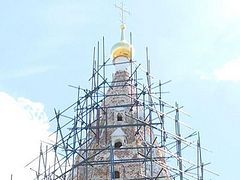
Subscribe to our mailing list
- Orthodoxy Today
- Homilies and Spiritual Instruction
- Saints. Asceties of Piety. Church Holy Days
- Churches and Monasteries
- Church History
- Coming to Orthodoxy
- Sretensky Monastery
- Orthodoxy Around the World
- Suffering Church
- Church and State
- Marriage and Family
- Photogalleries
- LIVE DISCOURSE
- BLOG / OPINION
- SUBMIT PRESS RELEASE
- Advertisement
- Knowledge Partnership
- Media Partnership
- Art & Culture
Chardham Yatra set to begin tomorrow; CM Dhami extends warm wishes to devotees
Uttarakhand chief minister pushkar singh dhami has extended warm wishes to the devotees gearing up for the chardham yatra, which is set to commence on friday, may 10. he wished the pilgrims a safe and fulfilling journey while expressing hope that the event would be completed with joy and enthusiasm, just as in previous years..

Uttarakhand Chief Minister Pushkar Singh Dhami has extended warm wishes to the devotees gearing up for the Chardham Yatra, which is set to begin on Friday. He wished the pilgrims a safe and fulfilling journey while expressing hope that the event would be completed with joy and enthusiasm, as in previous years. Welcoming all the devotees who came for the Chardham Yatra, the Chief Minister conveyed his prayers to Baba Kedar, Maa Gangotri, Maa Yamunotri, and Badrivishal, seeking their blessings for a safe and successful Chardham Yatra.
"Just like last year, this year also the Chardham Yatra should be completed safely with joy and pomp," Dhami said. The Chief Minister expressed confidence that this year's event would surpass all previous records in terms of participation and overall success.
"The state government is continuously reviewing the preparations for the Chardham Yatra at every level," stated Dhami. "We are committed to ensuring that every devotee returns home with golden memories of their time spent in Devbhoomi Uttarakhand." The Chief Minister highlighted that the Chardham Yatra is a significant event for the state, attracting lakhs of devotees from across the country and abroad. With over 20 lakh registrations for the Yatra so far this year, the state government is working tirelessly to ensure a smooth and safe journey for all.
Dhami remarked that the arrangements being made are not only to ensure a successful Yatra but also to leave a lasting impression on the devotees, encouraging them to return to Uttarakhand in the future. "The state government is making efforts for a safe Chardham Yatra. The preparations related to the Chardham Yatra are being continuously reviewed by the government at every level. Our effort will be that whichever devotee returns to his home after the end of the Yatra, the devotee should take with him the golden memories of the time spent in Devbhoomi Uttarakhand," Dhami said.
"Chardham Yatra is like a festival for Uttarakhand, and it has the special blessings of God," noted said. He urged everyone involved in the Yatra, from cleaning staff to police personnel and administrative officers, to do their best to ensure that no devotee faces any inconvenience. The Chief Minister concluded by appealing for mutual cooperation and emphasizing that, with God's blessings, the Chardham Yatra would be completed successfully and safely. This year's Chardham Yatra is expected to attract a record number of devotees, further boosting Uttarakhand's tourism industry and promoting the spiritual and cultural heritage of the region on a global scale.
"The state government is trying to provide every comfort and facility to the devotees when they come on the Char Dham Yatra, so that they make up their mind to come to Uttarakhand again and again in the future, which can boost our tourism industry. We all have to cooperate to ensure smooth and successful journey of all the devotees coming on the Char Dham Yatra so that more and more devotees can also help in spreading the message of our Devbhoomi in the country and the world," Dhami said. Earlier, as the doors of Kedarnath Dham are going to open tomorrow, the preparations are going on in full swing, with worship and Vedic chanting.
"The preparations for the opening of the doors are going on in full swing and the temple is being decorated with 40 quintals of flowers," said Badrinath-Kedarnath Temple Committee (BKTC) President Ajendra Ajay. Meanwhile, Uttarakhand Chief Minister Pushkar Singh Dhami also took to his official X handle and welcomed the devotees to Kedarnath Dham. The Chief Minister tweeted, "Hearty welcome and greetings to all the devotees in Shri Kedarnath Dham in Chardham Yatra-2024... Hail Lord Kedar!"
On the day of the opening of doors, performances will be given by nationally renowned bhajan singers from the decorated stage in the temple courtyard. This year, the Char Dham Yatra will begin on May 10, with the opening of three of the four shrines, including Gangotri, Yamunotri, and Kedarnath. The doors of Badrinath will open on May 12.
The Char Dham Yatra holds profound spiritual significance in Hinduism. This journey typically occurs from April-May to October-November. It is believed that one should complete the Char Dham Yatra in a clockwise direction.
Hence, the pilgrimage starts from Yamunotri, proceeds towards Gangotri, onto Kedarnath, and finally ends at Badrinath. (ANI)
(This story has not been edited by Devdiscourse staff and is auto-generated from a syndicated feed.)
- READ MORE ON:
- Uttarakhand
- Chardham Yatra
- Kedarnath Dham
- Devbhoomi Uttarakhand
- Chief Minister Pushkar Singh Dhami
- Char Dham Yatra
World Bank suspends Tanzania tourism fund over abuse allegations
Moscow city tourism committee organizes conference for indian mice market stakeholders, president of hemkund sahib meets uttarakhand governor, invites him for pilgrimage, mizoram witnesses surge in tourism with over 1.96 lakh visitors, including foreigners, religious tourism spots like varanasi and ayodhya may soon outshine goa and agra.

Sports News Roundup: Golf-Korda keeping it simple ahead of LPGA record attem...

Health News Roundup: AstraZeneca says it will withdraw COVID-19 vaccine glob...

GLOBAL MARKETS-Asia stocks slip, dollar climbs as Fed rate path pondered

INSIGHT-In rapidly ageing China, millions can't afford to retire
Latest news, opposition intensitifies pressure, meets haryana governor to push for bjp government's ouster, chinese companies hit with us trade restrictions over spy balloon incident, nomination papers filed for lok sabha elections in punjab: bjp's hans, congress's zira, and bsp's garhi submit candidacies, tripura governor visits ayodhya's ram temple, says he has come to offer prayers on parents' behalf.

OPINION / BLOG / INTERVIEW
Green metropolises: navigating the path to sustainable urban growth globally, the creative frontier: unleashing potential with generative ai, customized minds: the ai revolution in learning and behavioral change, transformative strategies for high-density cities, connect us on.
- ADVERTISEMENT
- KNOWLEDGE PARTNERSHIP
- MEDIA PARTNERSHIP
- Agro-Forestry
- Economy & Business
- Energy & Extractives
- Law & Governance
- Science & Environment
- Social & Gender
- Urban Development
- East and South East Asia
- Europe and Central Asia
- Central Africa
- East Africa
- Southern Africa
- West Africa
- Middle East and North Africa
- North America
- Latin America and Caribbean
OTHER LINKS
- Write for us
- Submit Press Release
- Opinion / Blog / Analysis
- Business News
- Entertainment News
- Technology News
- Law-order News
- Lifestyle News
- National News
- International News
OTHER PRODUCTS
Email: [email protected] Phone: +91-720-6444012, +91-7027739813, 14, 15
© Copyright 2024

IMAGES
VIDEO
COMMENTS
The Mayflower was a merchant ship that carried 102 passengers, including nearly 40 Protestant Separatists, on a journey from England to the New World in 1620. ... Pilgrims Before the Mayflower ...
Mayflower was an English sailing ship that transported a group of English families, known today as the Pilgrims, from England to the New World in 1620. After 10 weeks at sea, Mayflower, with 102 passengers and a crew of about 30, reached what is today the United States, dropping anchor near the tip of Cape Cod, Massachusetts, on November 21 [ O ...
Mayflower, the ship that carried the Pilgrims from England to Plymouth, Massachusetts, in 1620. Although no detailed description of the original vessel exists, marine archaeologists estimate that the square-rigged sailing ship weighed about 180 tons and measured 90 feet (27 metres) long.
Pilgrims boarding the Mayflower for their voyage to America. The Pilgrim's arduous journey to the New World technically began on July 22, 1620, when a large group of colonists boarded a ship ...
The Mayflower was hired in London, and sailed from London to Southampton in July 1620 to begin loading food and supplies for the voyage--much of which was purchased at Southampton.The Pilgrims were mostly still living in the city of Leiden, in the Netherlands. They hired a ship called the Speedwell to take them from Delfshaven, the Netherlands, to Southampton, England, to meet up with the ...
The 102 Mayflower passengers were a diverse group made up of religious separatists (later known as pilgrims) and others referred to by the pilgrims as Strangers (people who did not share their faith). The ship also had a crew of approximately 30 (possibly 50) captained by Christopher Jones (l. c. 1570-1622 CE) of Rotherhithe, England.
The Mayflower was intended to land in Virginia, but storms shifted the ship's course north. As a result, they landed in Cape Cod, Massachusetts. After exploring the area, the Mayflower pilgrims eventually decided to stay, partially due to harsh seas and dwindling supplies. John Smith, the famous explorer, had previously named the area ...
The Mayflower set sail on 16th September 1620 from Plymouth, UK, to voyage to America. But its history and story start long before that. Its passengers were in search of a new life - some seeking religious freedom, others a fresh start in a different land. They would go on to be known as the Pilgrims and influence the future of the United ...
The Mayflower is the name of the cargo ship that brought the Puritan separatists (known as pilgrims) to North America in 1620 CE. It was a type of sailing ship known as a carrack with three masts with square-rigged sails on the main and foremast, three decks (upper, gun, and cargo), and measured roughly 100 feet (27 m) long and 25 feet (7 m) wide. The pilgrim passengers, and those not ...
The Mayflower Voyage . The group that set out from Plymouth, in southwestern England, in September 1620 included 35 members of a radical Puritan faction known as the English Separatist Church. In ...
The Embarkation of the Pilgrims (1857) by American painter Robert Walter Weir at the Brooklyn Museum. The Pilgrims, also known as the Pilgrim Fathers, were the English settlers who traveled to America on the Mayflower and established the Plymouth Colony in Plymouth, Massachusetts (John Smith had named this territory New Plymouth in 1620, sharing the name of the Pilgrims' final departure port ...
The Mayflower's Voyage; The Mayflower's Crew; Inside the Mayflower: Cross-sections; What did they bring? Provision lists; Women on the Mayflower; Girls on the Mayflower; The End of the Mayflower; ... Religious Beliefs of the Pilgrims; History of the Thanksgiving Holiday; Clothing of the Pilgrims; Visiting Modern-Day Plymouth; MayflowerHistory ...
Navigation in 1620: The. Mayflower. Was One of the Lucky Ones. From Diamond Jubilee Edition 27. Robert A. Harper. Presented at a meeting of the Myles Standish Colony of the Florida Society, in Naples, Florida. W hen I first thought of discussing the art of navigation in 1620 and how Captain Christopher Jones of the Mayflower probably employed ...
The Mayflower started its legendary voyage from Plymouth to the New World in September 1620. Apart from a crew of around 30 people, there were 102 passengers on the ship. The pilgrims paid Jones to take them to northern Virginia. Jones was a 50-year-old man from Essex, England. He was a sea veteran who valued money and freedom.
In order to finance the voyage, the Pilgrims were forced ... after the Mayflower landed far north of its target in Massachusetts in November 1620, Pilgrim leaders drew up the Mayflower Compact ...
When the ship got back to England, John and Myles decided to stay in Plymouth Colony rather than go home. Priscilla Mullins started on the voyage with her father, stepmother, and brother. It was a challenging year for Plymouth. It had been tough before, but then tragedy struck, and Priscilla lost her whole family.
Travel Walk through a 1667 Plymouth home where Mayflower pilgrims lived About 2 million people in the U.S., including three presidents, can trace their ancestry to the pilgrim family who lived there.
Mayflower AI sea drone, or Mayflower Autonomous Ship, or Mayflower 400 (MAS400) is an autonomous research vessel that aims to cross the Atlantic without human crew or assistance. It is named after the Mayflower sailing ship, that carried English and Dutch Pilgrims onboard from England to New England between September and November 1620.
The Mayflower Compact was a set of rules for self-governance established by the English settlers who traveled to the New World on the Mayflower.When Pilgrims and other settlers set out on the ship ...
In 1620, the famous ship Mayflower carrying its hundred or so passengers arrived from Britain to the United States, the dangerous journey having taken several months. In 1925, a hotel in Washington, D.C. was named "Mayflower" in its honor. This is the hotel where, on April 27, 2016, The Center for the National Interest (CNI), a Washington, D.C ...
A hotel for pilgrims will soon open in one of the buildings of the monastery, said abbot Bishop Thomas of Bronnitsy. The restoration of artistic tombstones of the Donskoy necropolis is also carried out with funds from the city budget. 23 such tombs were restored over the summer and it is planned to restore 7 more. On ...
Crocus City Hall attack. / 55.82583°N 37.39028°E / 55.82583; 37.39028. On 22 March 2024, a terrorist attack which was carried out by the Islamic State (IS) occurred at the Crocus City Hall music venue in Krasnogorsk, Moscow Oblast, Russia. The attack began at around 20:00 MSK ( UTC+3 ), shortly before the Russian band Picnic was ...
Uttarakhand Chief Minister Pushkar Singh Dhami has extended warm wishes to the devotees gearing up for the Chardham Yatra, which is set to commence on Friday, May 10. He wished the pilgrims a safe and fulfilling journey while expressing hope that the event would be completed with joy and enthusiasm, just as in previous years.